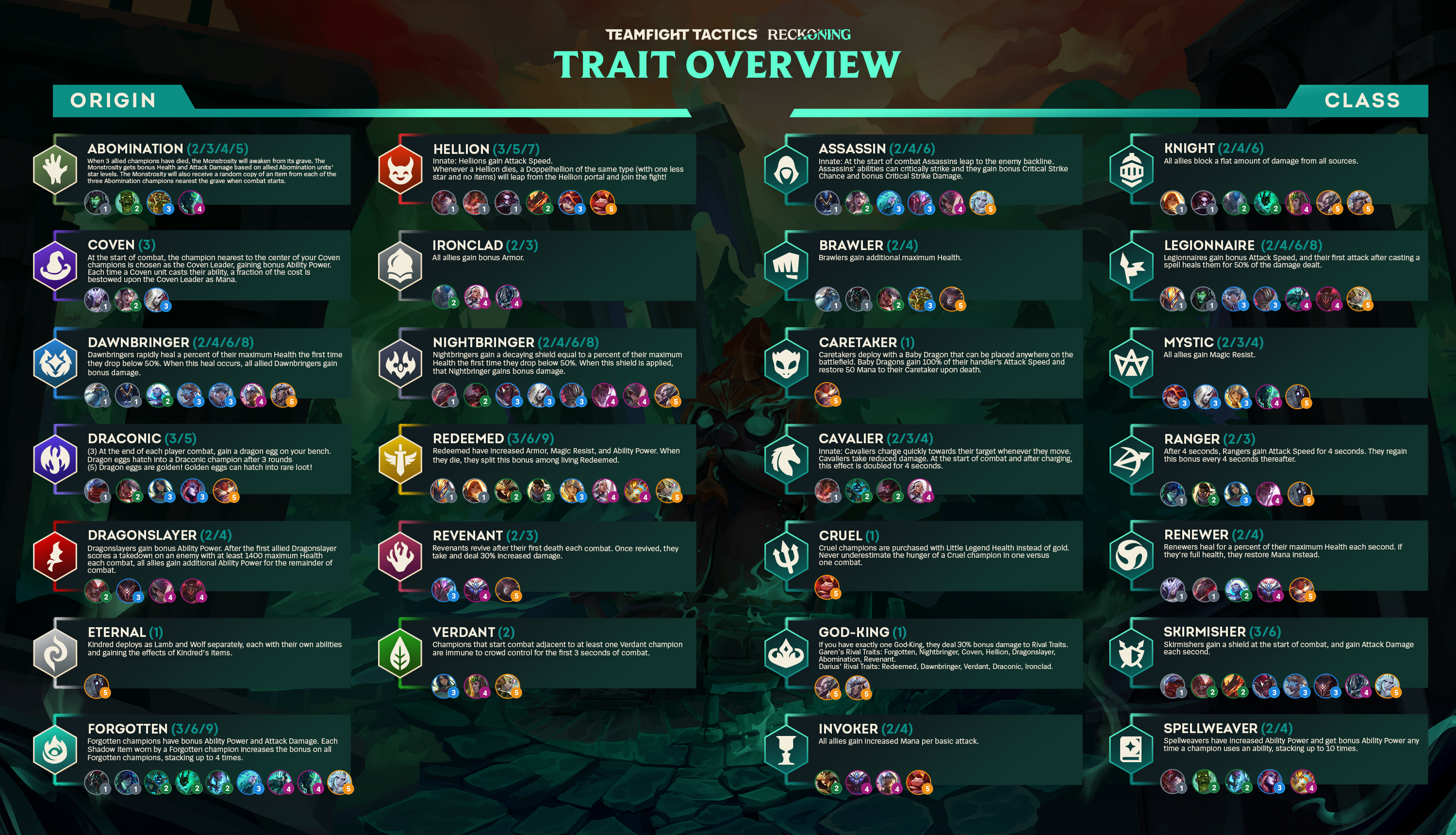Everything New in TFT Set 5: Reckoning
TFT Set 4 is coming to a close and everyone is excited to try out Set 5 on PBE. The Chosen mechanic is not returning, but we have a whole lot of other mechanics coming to TFT.
If you don’t know about the new set mechanics yet, make sure to check out our TFT website to understand all the changes coming to the game.
In this article, we’ll be going over every new Trait and Champion in Set 5, along with some first impressions.
Keep in mind that all of this information is subject to change. Champions, synergies, and items will all be updated very regularly on the PBE server, so make sure to check out our Champion and Synergy Pages to stay up to date with everything.
New Traits
If you want a solid overview of all the new traits and champions, check out this cheat sheet provided by Riot Games.
New Origins
With the cheatsheet as a guide, let’s go into each trait starting with the Origins. To view the updated numbers for the Origins, check out our Synergy Page for in depth info.
Abomination

Bonus: When 3 allied Champions have died, the Monstrosity will awaken from its grave. The Monstrosity gets bonus Health and Attack Damage based on allied Abomination units’ Star Levels. The Monstrosity will also receive a random copy of an item from each of the three Abomination Champions nearest the grave when combat starts.
Champions: Kalista, Brand, Nunu, Ryze
First Impressions: Mech-Pilots are back in a spookier form with Abomination. Abomination seems like a very nice trait to have in the game as strong hyper carry units like the Abomination will be able to use defensive items very well. One important thing to note is that the Abomination takes items from the three closest Abomination units. This means you can’t stack all your items onto one Abomination and have ideal items every time. You will need to split your ideal items across 3 units and not use other items if you want to guarantee what items the Abomination has.
Coven

Bonus: At the start of combat, the Champion nearest to the center of your Coven Champions is chosen as the Coven Leader, gaining 50% bonus Ability Power.
Champions: Lissandra, Leblanc, Morgana
First Impressions: This is another trait that relies a lot of positioning. One important thing to note is that this trait doesn’t necessarily have to buff a Coven unit. You could use Coven as a supporting trait to beef up your main carry assuming you can position your carry in the middle of your Coven.
Dawnbringer

Bonus: Dawnbringers rapidly heal some of their maximum Health the first time they drop below 50%. When this heal occurs, all allied Dawnbringers gain 10% bonus damage.
Champions: Gragas, Kha’Zix, Soraka, Nidalee, Riven, Karma, Garen
First Impressions: Dawnbringers are an interesting trait in that they provide a pseudo Guardian Angel effect with their healing. This means you could potentially run 3 offensive items on your main carry if the Dawnbringer heal is enough to keep them alive.
Draconic

Bonus: At the end of each player combat, gain a dragon egg on your bench. The bigger the egg, the longer it takes to hatch, and the rarer the reward. In Hyper Roll, dragon eggs hatch a lot faster.
Champions: Udyr, Sett, Ashe, Zyra, Heimerdinger
First Impressions: It wouldn’t be TFT without a trait like Space Pirates or Fortune. Draconic is the new trait that allows you to gain loot throughout the game. Players will need to test the specifics of the loot table, but I’m sure there will be innovators working at it from the start of the Set.
Dragonslayer

Bonus: Dragonslayers gain bonus Ability Power. After the first ally Dragonslayer scores a takedown on an enemy with at least 1400 maximum Health, all allies gain additional Ability Power for the rest of the round.
Champions: Trundle, Pantheon, Diana, Mordekaiser
First Impressions: Dragonslayers are an interesting trait. They specialize in buffing Ability Power, meaning they are mostly magic damage carries. The main focus will be on Diana as I believe she has the best carry potential out of these units.
Eternal

Bonus: Wolf separates from Lamb to become a second champion. Wolf does not count toward your unit cap, and receives all of Lamb’s item bonuses.
Champions: Kindred
First Impressions: Traits that only involve 5-cost units are always very powerful. Even if Kindred is too strong or too weak on release, Riot will buff or nerf her accordingly to make her a powerful late game unit.
Forgotten

Bonus: Forgotten champions have bonus Attack Damage and Ability Power. Each Shadow item held by a Forgotten champion increases these bonuses by 10% on all Forgotten champions, stacking up to 4 times.
Champions: Warwick, Vayne, Hecarim, Thresh, Viktor, Katarina, Draven, Ryze, Viego
First Impressions: Forgotten seems to be the flagship trait for the Set. Their buff ties in directly with the new set mechanic: Shadow Items. There’s a whopping 9 units in the origin, so these units will very likely be used in a variety of compositions.
Hellion

Bonus: Hellions gain Attack Speed.Whenever a Hellion dies, a Deoppelhellion of the same type (with one less star and no items) will leap from the Hellion portal and join the fight!
Champions: Ziggs, Kled, Poppy, Kennen, Lulu, Teemo
First Impressions: Attack speed buffs are always nice in any trait. More attack speed means more damage and more mana gained. Teemo is an especially interesting carry as he costs health to buy instead of gold. It will be interesting to see how this affects how players play this team comp going forward.
Ironclad

Bonus: All allies gain Armor.
Champions: Nautilus, Rell, Jax
First Impressions: There isn’t anything super special about this trait. It’s basically an Armor version of Mystic that applies to your entire team. This trait will likely be easy to splash into many team comps, much like how Mystic is often splashed into teams.
Nightbringer

Bonus: Nightbringers gain a shield for 8 seconds equal to a percent of their maximum Health the first time they drop below 50%. When this occurs, that Nightbringer gains bonus damage.
Champions: Vladimir, Sejuani, Lee Sin, Morgana, Yasuo, Aphelios, Diana, Darius
First Impressions: Nightbringer is the evil equivalent of Dawnbringer. Their effect is very similar, in that they get bonus survivability once they hit 50% health. This comp will likely see early play much like Dawnbringer as they are simple to play with a high trait count.
Redeemed

Bonus: Redeemed have increased Armor, Magic Resistance, and Ability Power. When they die, they pass this bonus split among remaining Redeemed allies.
Champions: Aatrox, Leona, Syndra, Varus, Lux, Rell, Vel’Koz, Kayle
First Impressions: This trait is somewhat similar to how Nobles played in Set 1. They have a trait that gives them many increased stats. However, they also are like Dark Stars from Set 3 with how their buff is split upon death. The great part about this buff transfer is that it is split evenly instead of passing onto a nearby ally. This makes positioning with them flexible compared to something like Dragonsoul in Set 4.
Revenant

Bonus: Revenants revive after their first death each combat. Once revived, they take and deal 30% increased damage.
Champions: Nocturne, Ivern, Volibear
First Impressions: Based on the champion abilities, I don’t believe this trait is meant to carry team comps. It’s a small trait that seems to be more about splashable frontline and CC rather than carry damage.
Verdant

Bonus: Champions that start combat adjacent to at least one Verdant ally are immune to crowd control for a duration.
Champions: Ashe, Taric, Kayle
First Impressions: Right off the bat, this trait looks amazing to me. Kayle seems like a scary 5 cost carry, and having an innate Quicksilver ability gives her one more item slot for other things. Unfortunately, the 2 trait bonus is only 3 seconds, so it likely will be stronger and better at 3 units.
Classes
Now that we’ve seen all the origins, let’s go into the classes. Just like for the Origins make sure to check out the Synergy Page for more in depth numbers and any updates made in the PBE.
Assassin

Bonus: Innate: At the start of combat Assassins leap to the enemy backline. Assassins’ abilities can critically strike and they gain bonus Critical Strike Chance and bonus Critical Strike Damage.
Champions: Kha’Zix, Leblanc, Katarina, Nocturne, Diana, Viego
First Impressions: It wouldn’t be TFT without an Assassin type trait. Assassins always squeeze their way into the meta with their unique leaping passive. Having a 5-cost Assassin is also quite intriguing.
Brawlers

Bonus: Brawlers gain additional maximum Health.
Champions: Gragas, Warwick, Sett, Nunu, Volibear
First Impressions: Brawlers have been in the game for a quite a while now, so there’s not too much to comment about them. They don’t have very many Brawlers, so it will likely be more splashable into team comps rather than being their own comp in this Set.
Caretaker

Bonus: Caretakers deploy with a Baby Dragon that can be placed anywhere on the battlefield. Baby Dragons gain 100% of their handler’s Attack Speed and restore 50 mana to their Caretaker upon death.
Champions: Heimerdinger
First Impressions: Heimerdinger is kind of like Azir from Set 4. He summons a Baby Dragon turret like an Azir Sand Soldier except this turret will deal a good amount of damage when combined with his ability.
Cavalier

Bonus: Innate: Cavaliers charge quickly towards their target whenever they move. Cavaliers take reduced damage. At the start of combat and after charge, this effect is doubled for 4 seconds.
Champions: Kled, Hecarim, Sejuani, Rell
First Impressions: Cavaliers have interesting potential as a frontline, but I somewhat doubt the trait will go more than 2 units. There is only 1 4-cost unit in Rell, so the others will likely be replaced in the late game unless they are used for synergy.
Cruel

Bonus:
Cruel champions are purchased with Little Legend Health instead of gold. They can be sold for gold but not Health. You’re welcome. Never underestimate the hunger of a Cruel champion in single combat.
Champions: Teemo
First Impressions: Teemo is the little flair unit of this set. Spending 5 health per copy of Teemo is quite the cost. Lose streaking and going for a Teemo comp is extremely risky. He may be splashable into many team comps, but he will probably have his own comp where he is the main or secondary carry.
God-King

Bonus: If you have exactly one God-King they deal 30% bonus damage to enemies who have at least one of their Rival Traits.
- Garen’s Rival Traits: Forgotten, Nightbringer, Coven, Hellion, Dragonslayer, Abomination, Revenant
- Darius’ Rival Traits: Redeemed, Dawnbringer, Verdant, Draconic, Ironclad
Champions: Darius, Garen
First Impressions: The God-Kings are more 5-cost units that provide extra flair to the set. Almost every trait pertains to a side of light or dark. Garen and Darius will deal more damage to opposing enemies with rival traits. They will deal bonus damage to each other, so it’ll be interesting to see which carry comes out on top in the end.
Invoker

Bonus: All allies gain extra Mana from their basic attacks.
Champions: Syndra, Ivern, Karma, Teemo
First Impressions: Instead of a Mage class providing more damage, this Invoker class provides more mana generation. Karma looks to be a solid carry for Invokers as well, while Ivern is more of a support utility unit for Invokers.
Knight

Bonus: All allies block a flat amount of damage from all sources.
Champions: Leona, Poppy, Nautilus, Thresh, Taric, Darius, Garen
First Impressions: Knights are the new Vanguard providing a damage reduction rather than defensive stats. This makes them quite strong in the early game by blocking small damage numbers, but unless the numbers scale well, they may not be tanky enough to survive the late game damage from other units.
Legionnaire

Bonus: Legionnaires gain bonus attack speed, and their first attack after casting a spell heals them for 50% of the damage dealt.
Champions: Aatrox, Kalista, Riven, Yasuo, Draven, Mordekaiser, Kayle
First Impressions: Legionnaires are the new Duelist gaining a some attack speed. But instead of scaling attack speed, they gain a bit of survivability. This intrigues me as it opens item slots for carries when they already have some innate survivability.
Mystic

Bonus: All allies gain Magic Resist.
Champions: Lulu, Morgana, Lux, Ryze, Kindred
First Impressions: Mystic started in Set 2 and has been a recurring trait ever since. They provide a strong game balance mechanic while also being very flexible in many team comps.
Ranger

Bonus: After 4 seconds, Rangers gain Attack Speed for 4 seconds. They regain this bonus every 4 seconds thereafter.
Champions: Vayne, Varus, Ashe, Aphelios, Kindred
First Impressions: Rangers are finally back with their patented attack speed buffs. Statikk Shiv may finally make a comeback with these units. Having a 4-cost and 5-cost carry also makes them extremely enticing.
Renewer

Bonus: Renewers heal for a percent of their maximum Health each second. If they’re full health, they restore mana instead.
Champions: Lissandra, Vladimir, Soraka, Ivern, Heimerdinger
First Impressions: Renewer is another trait like Invoker that gives mana generation, assuming the unit is full health. This seems to be a very strong trait to run alongside Heimerdinger to provide him with a lot of mana to carry.
Skirmisher

Bonus: Skirmishers gain a shield at the start of combat, and gain Attack Damage each second.
Champions: Udyr, Trundle, Kennen, Lee Sin, Nidalee, Pantheon, Jax, Viego
First Impressions: Skirmishers have scaling attack damage throughout the fight, so it may be more efficient to build defensive or attack speed items instead. They seem a bit difficult to fit into comps as they run 3 and 6 units, but we will see.
Spellweaver

Bonus: Spellweavers have increased Ability Power and get bonus Ability Power any time a champion uses an ability, stacking up to 10 times.
Champions: Ziggs, Brand, Viktor, Zyra, Vel’Koz
First Impressions: Spellweavers are the new magic damage class that boosts Ability Power. The trait clearly intends to use Vel’Koz as a carry, but his ability will need to have good targeting in order to be able to carry.
New Champions: First Impressions and Positioning
For this section, I’ll be giving some brief thoughts on every new champion in Set 5. There’s a whopping 58 to go through, so let’s get into it.
Positioning Key
We’ll be giving basic positioning suggestions for every champion to get the ball rolling for you, but remember that positioning is incredibly contextual in TFT and to always adapt to the situation at hand.
The terminology we’ll be using in this article will be frontline, midline, and backline.
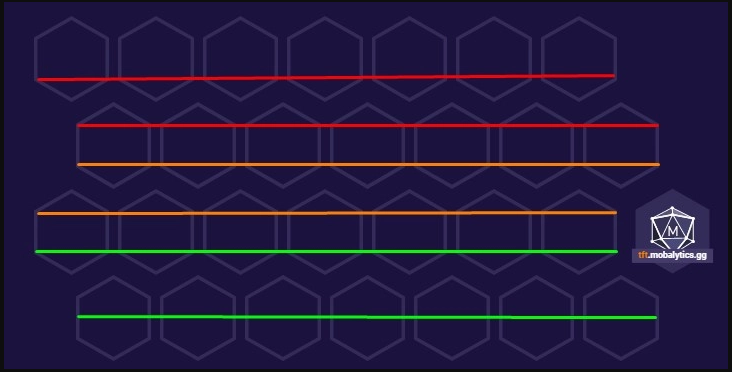
1-Cost Champions
Aatrox – Redeemed Legionnaire

[See Aatrox’s TFT champion page]
First Impressions: Aatrox’s ability is quite simple and is very similar to something like Wukong from Set 4. His ability doesn’t stun though and he heals himself instead. He can be a decent holder for attack damage items in the very early game. The redeemed trait gives him some extra survivability while Legionnaire gives extra attack speed. He seems like a decent early game unit, but usually players prefer ranged or Assassin units to hold damage items early.
Positioning: Frontline / Midline
Gragas – Dawnbringer Brawler
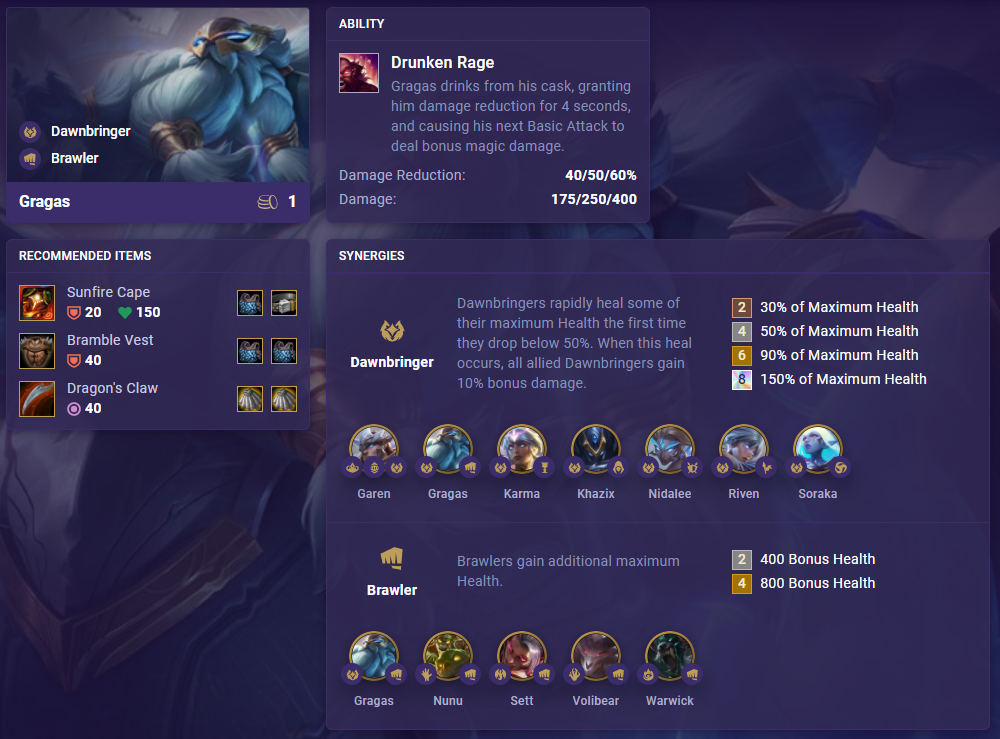
[See Gragas’s TFT champion page]
First Impressions: Gragas’ ability does a little bit of damage, but his main role will be as a frontline tank. Brawlers are a solid option for early game frontline, and the damage with his ability is nice. He reminds me of a unit like Maokai from Set 4. He is a tanky frontline with a small damage ability.
Positioning: Frontline
Kalista – Abomination Legionnaire
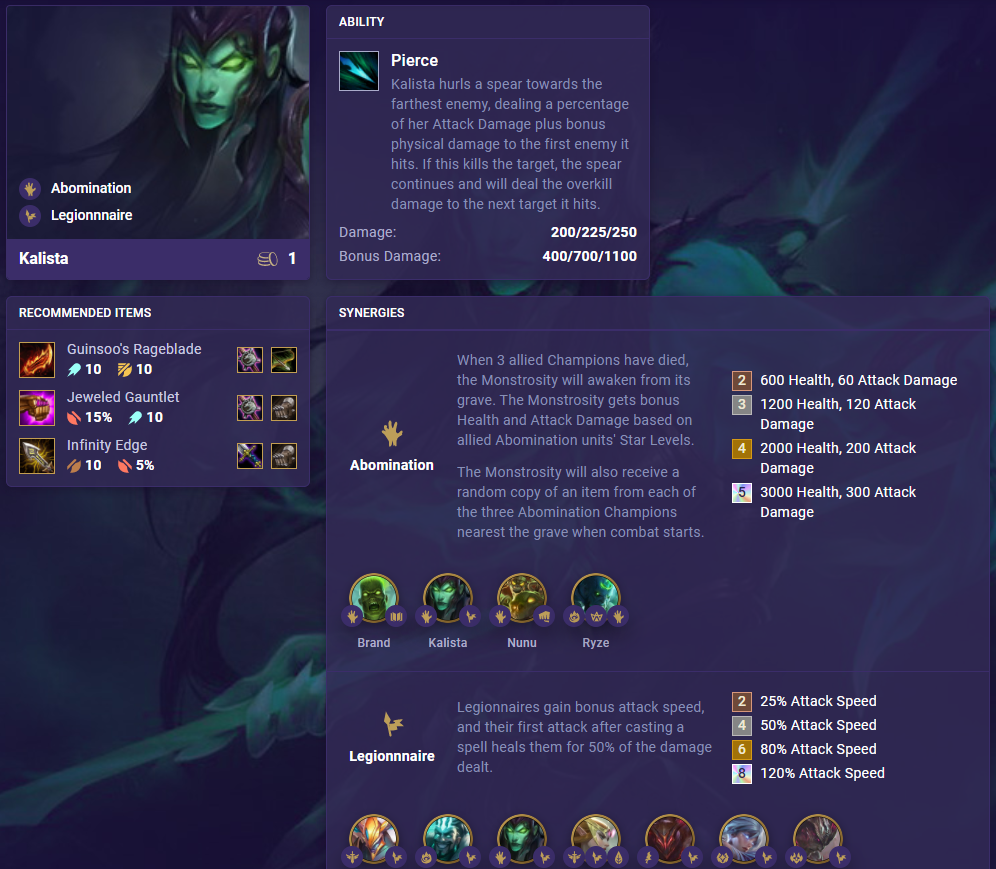
[See Kalista’s TFT champion page]
First Impressions: Kalista is the new version of Nidalee for Set 5. She hurls a spear that contacts the first enemy hit. However, instead of more damage for distance, her spear will pierce and deal overkill damage to the next unit. Kalista will provide solid attack speed as a Legionnaire, but more people will likely look at her for her potential as an Abomination unit.
Positioning: Backline
Kha’Zix – Dawnbringer Assassin
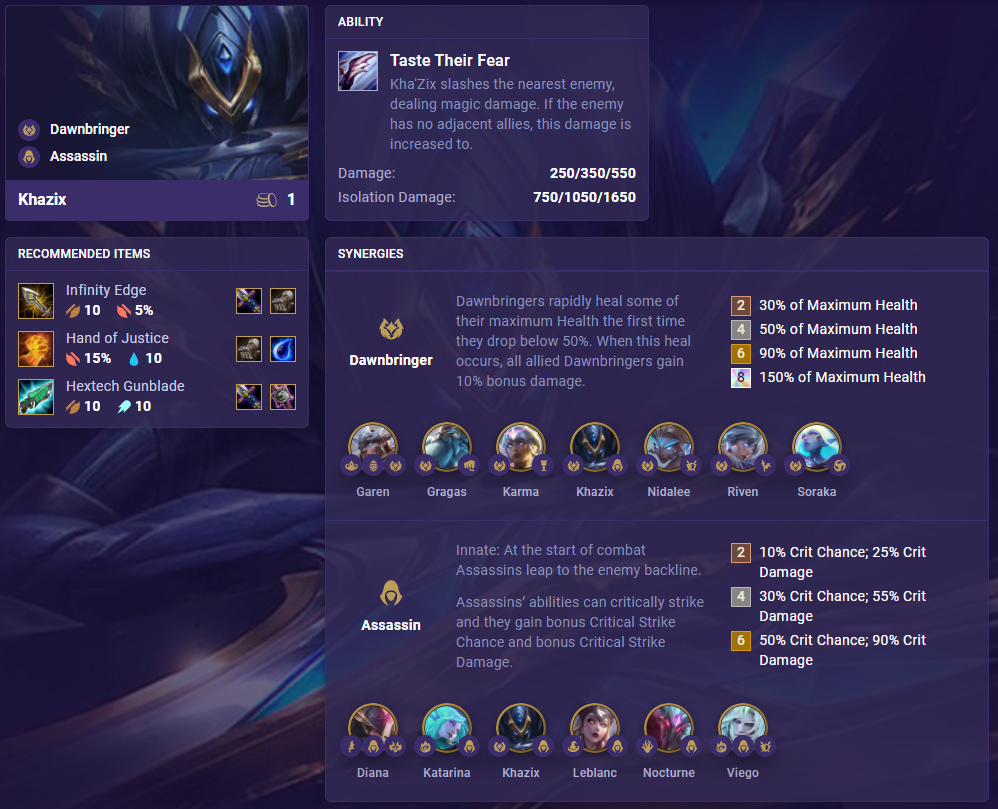
[See KhaZix’s TFT champion page]
First Impressions: Kha’Zix is back with the same ability as Set 1. He has a simple single target damage ability that deals more damage if units are isolated. Kha’Zix is quite strong usually in the early game where there are less units on the board. It’s unlikely he will become a hyper carry candidate, but he likely will be a solid pickup early game for damage.
Positioning: Backline
Kled – Hellion Cavalier
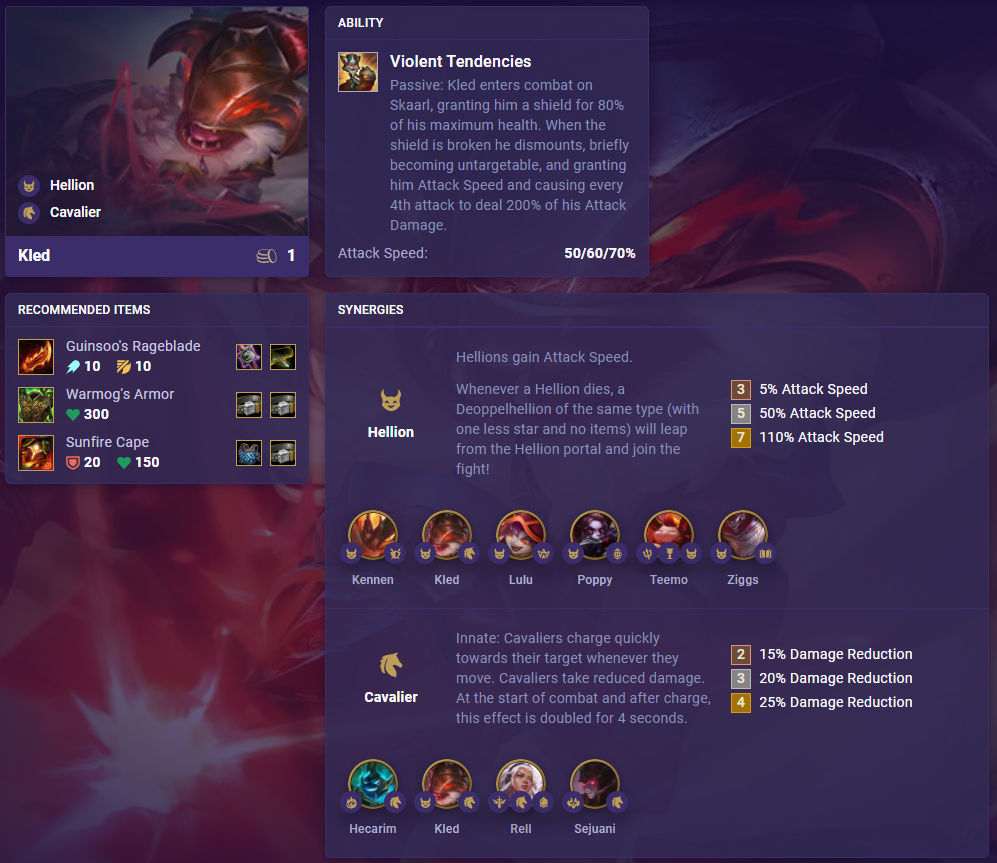
[See Kled’s TFT champion page]
First Impressions: Usually when an ability has a lot of words, it means that it’s quite good. Unfortunately, without knowing his base stats, we can’t conclude too many things about Kled. However, he will provide a solid frontline for the early game. His ability also allows him to deal decent damage after he dismounts.
Positioning: Frontline
Leona – Redeemed Knight
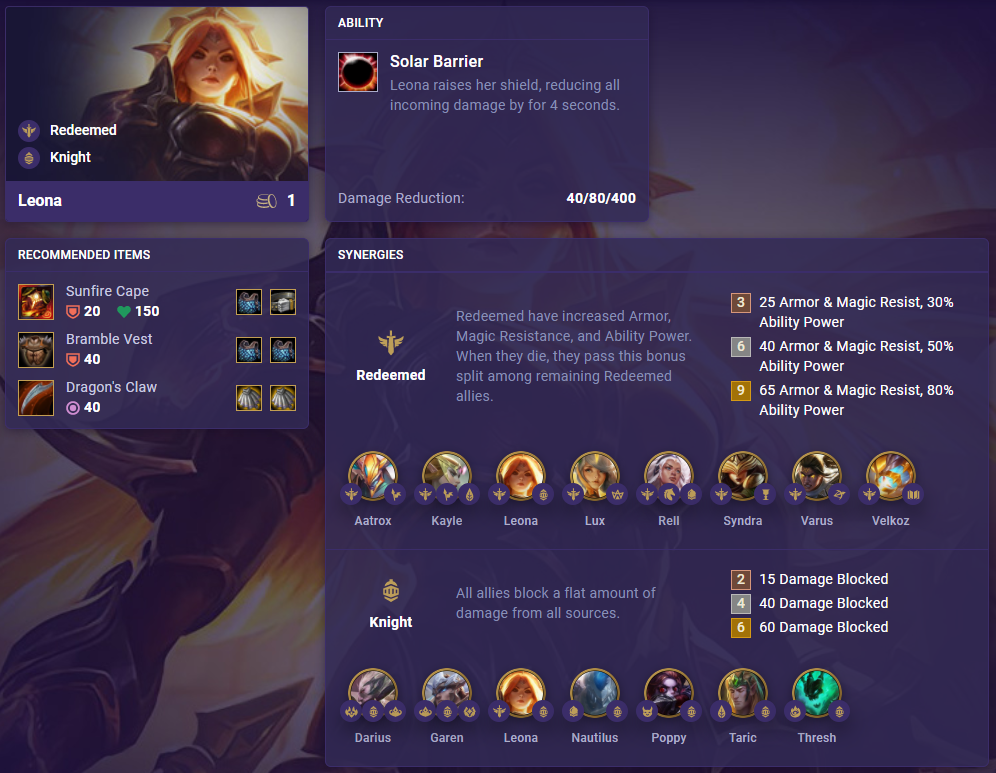
[See Leona’s TFT champion page]
First Impressions: Leona a a pure tank. Her only job is to be a beefy frontliner to stall for your damage dealers. Her damage reduction in the early game can be extremely strong, especially if combined with other Knights.
Positioning: Frontline
Lissandra – Coven Renewer
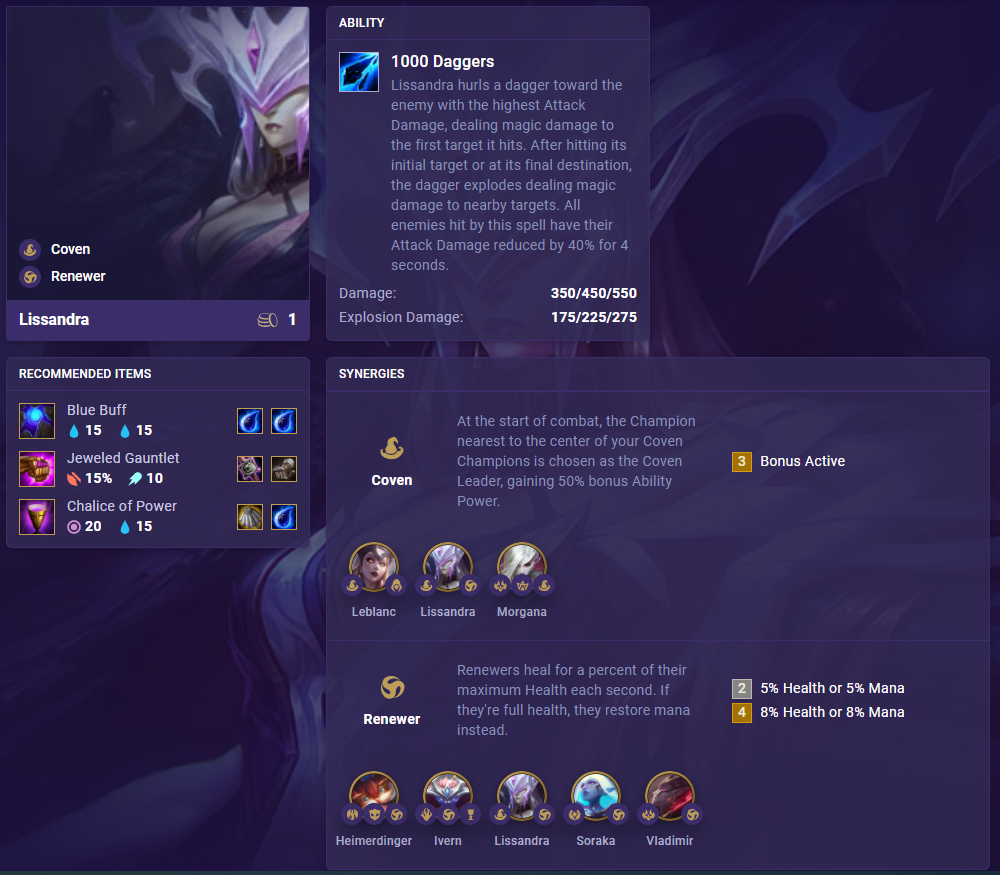
[See Lissandra’s TFT champion page]
First Impressions: Lissandra deals a solid amount of damage for a 1-cost unit, and will punish players who group their units together. Her attack damage debuff can also come in clutch in later stages of the game. If Renewers or Coven units see play, Lissandra will be a solid unit to have throughout the game. Make sure to position Lissandra well so that her ability isn’t absorbed by an enemy tank.
Positioning: Backline
Poppy – Hellion Knight
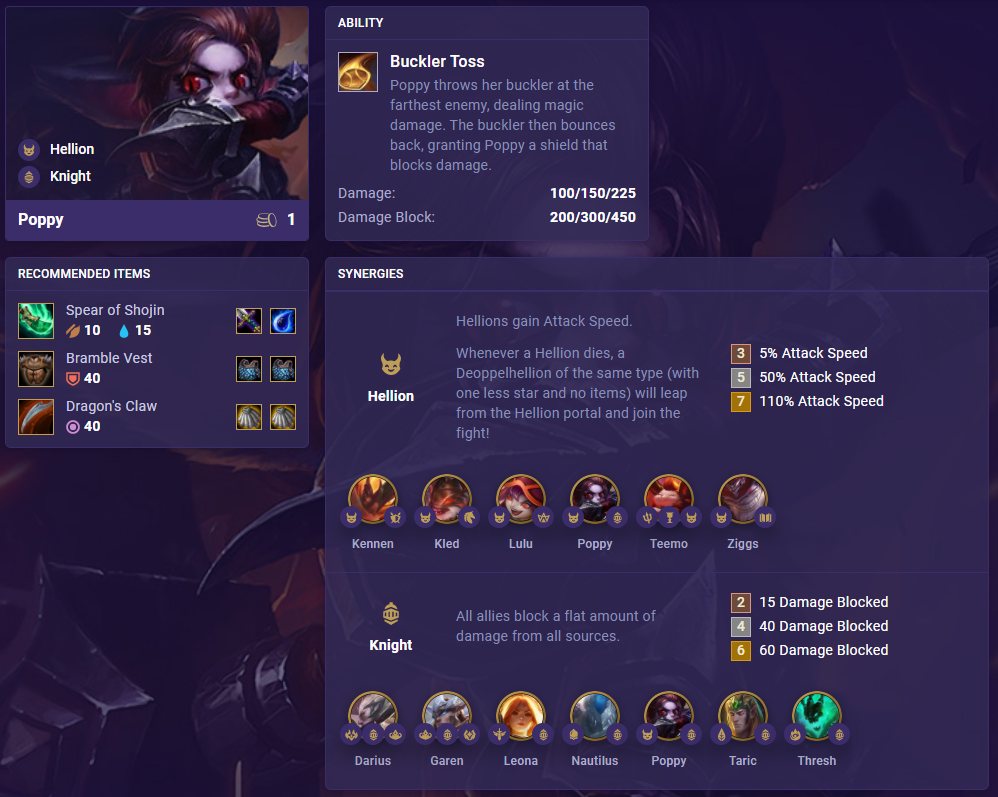
[See Poppy’s TFT champion page]
First Impressions: Poppy is another frontline tank that will pair very well early with Leona as a Knight duo. Her main function in the meta will be to provide frontline or to help transition into Hellion comps. I don’t see Poppy being used in the late game, but she likely will see play early game alongside other Knights. If her base stats are extremely strong, we may see potential in a hyper tank Poppy, but Riot will likely nip that in the bud quickly.
Positioning: Frontline
Udyr – Draconic Skirmisher
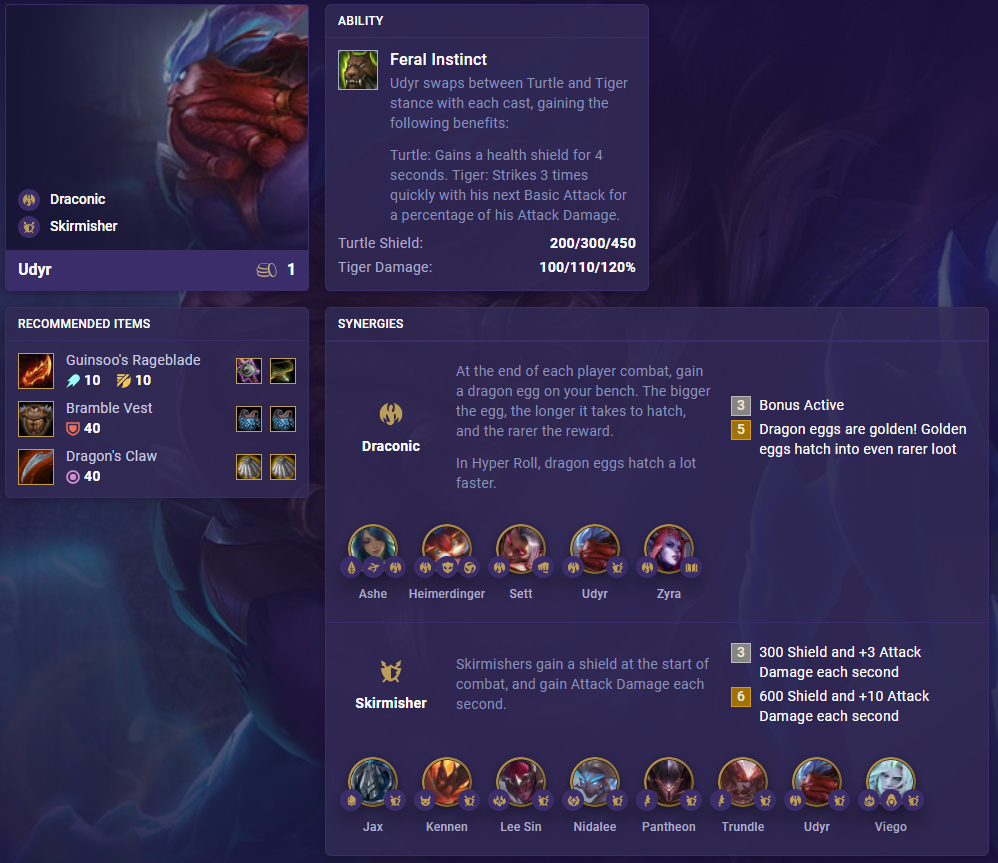
[See Udyr’s TFT champion page]
First Impressions: Udyr has a very unique ability that allows him to gain defensive and offensive abilities. He slowly will gain attack damage through Skirmisher, so things like Attack Speed or Crit will help scale his damage even better in the early game.
Positioning: Midline
Vayne – Forgotten Ranger
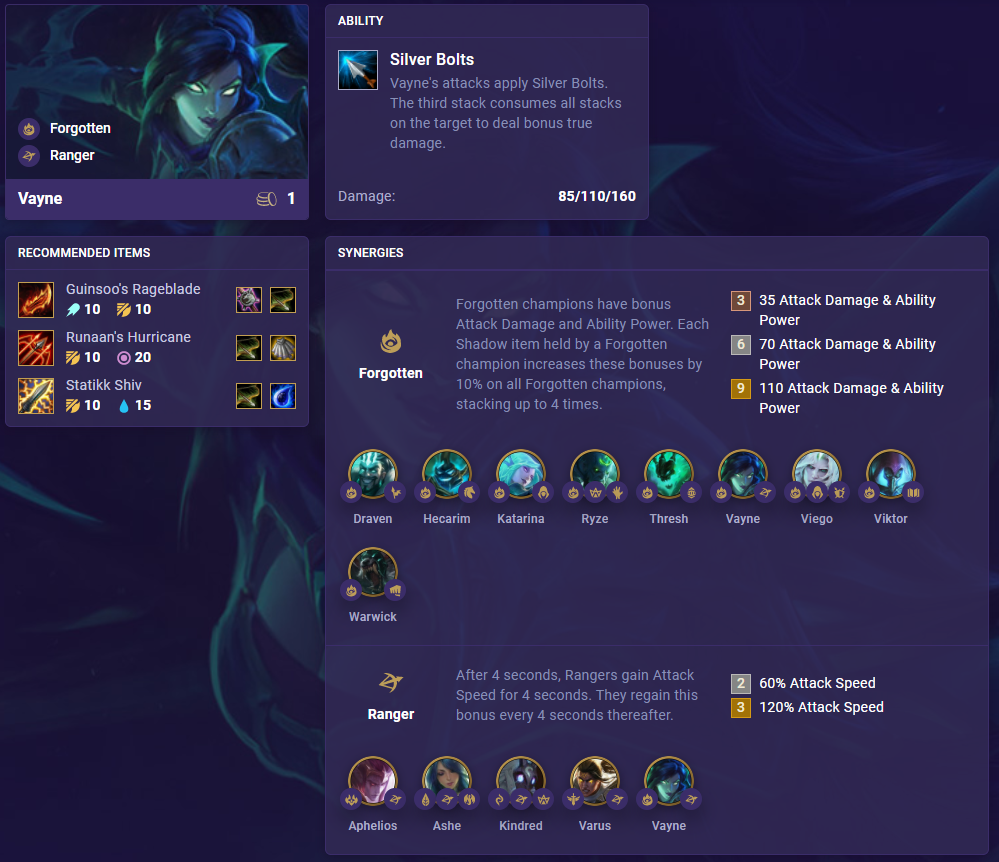
[See Vayne’s TFT champion page]
First Impressions: Vayne is back with her Silver Bolts ability and the classic Ranger trait. We’ve seen this many times before, so there isn’t much to say here. As usual, you she will do well with items like Hurricane which proc her Silver Bolts.
Positioning: Backline
Vladimir – Nightbringer Renewer

[See Vladimir’s TFT champion page]
First Impressions: Vladimir is also making a comeback with his simple single target damage ability. I don’t expect Vladimir to shake up the meta, but he will likely be a solid synergy and transition to use in the early and mid game stages of the game.
Positioning: Midline
Warwick – Forgotten Brawler
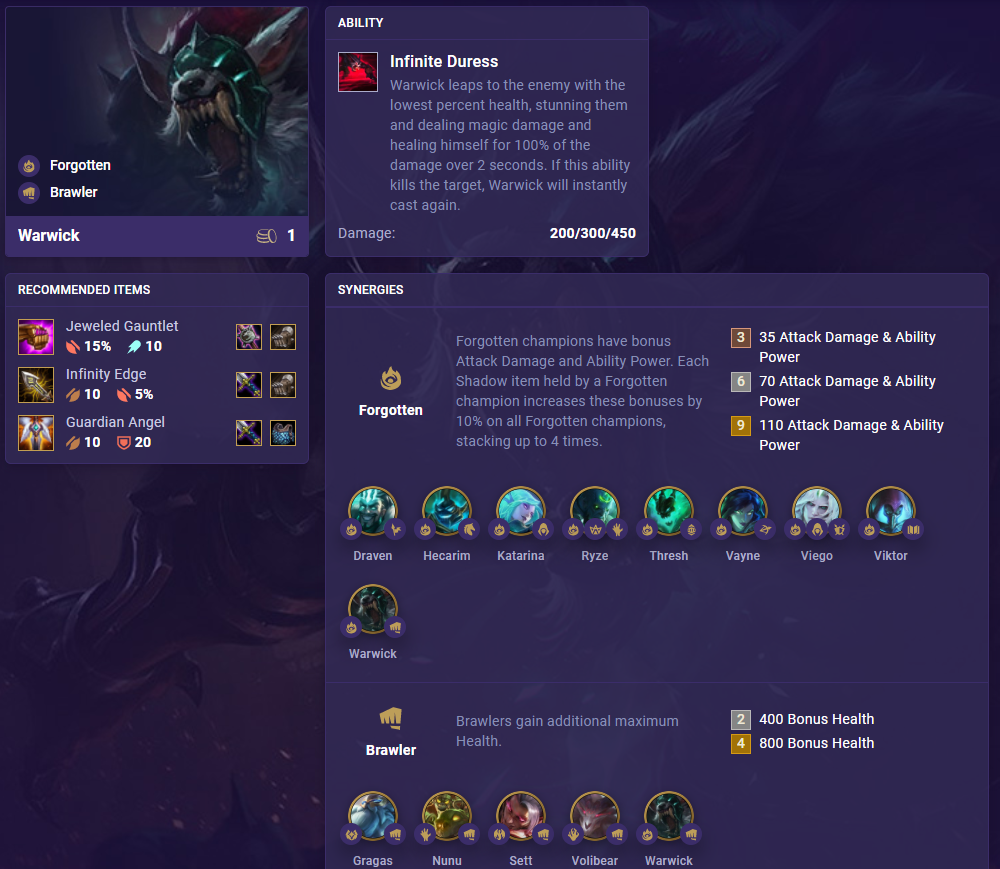
[See Warwick’s TFT champion page]
First Impressions: Warwick is very interesting as he has an ability that is very similar to Talon from Set 4. He will jump around to different targets if his ability kills the target. He has built in survivability with Brawler and healing through his ability, so I recommend you use him as an early game offensive item holder.
Positioning: Midline
Ziggs – Hellion Spellweaver
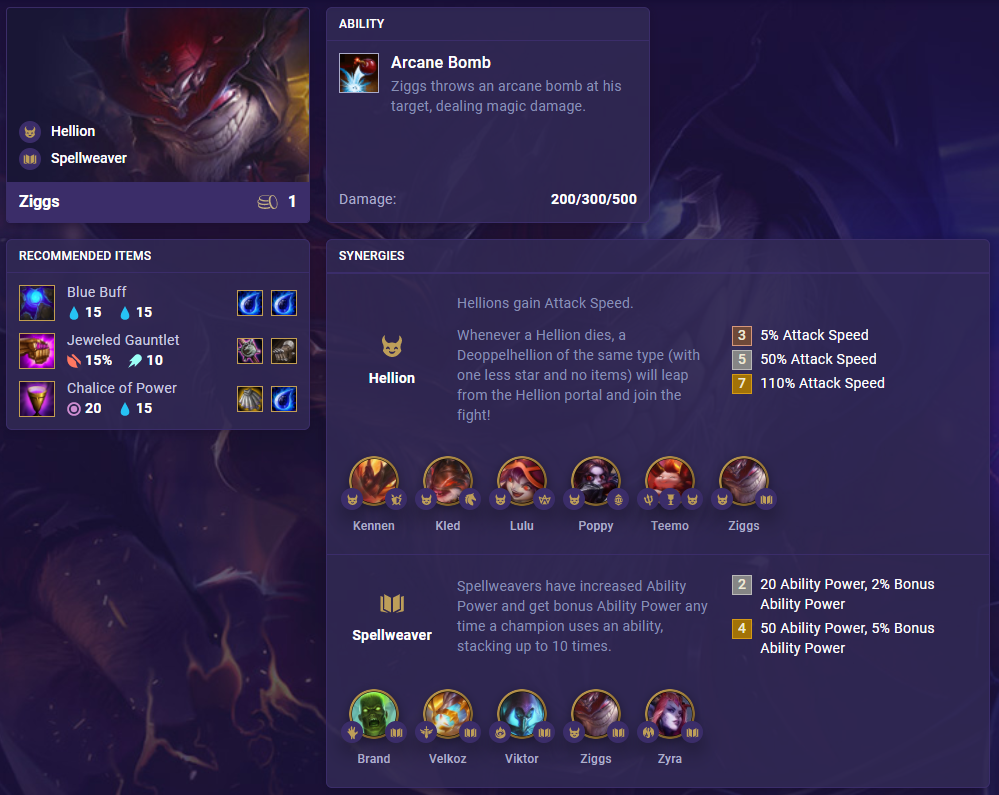
[See Ziggs’s TFT champion page]
First Impressions: Ziggs has a very simple single target damage ability, but if his mana pool is low, we may see Blue Buff make a comeback. Spellweavers want to cast multiple times, so having some mana items on a unit like Ziggs will help buff up your Spellweavers. Hellion units also have great synergy as attack speed leads to faster mana generation.
Positioning: Backline
2-Cost Champions
Brand – Abomination Spellweaver
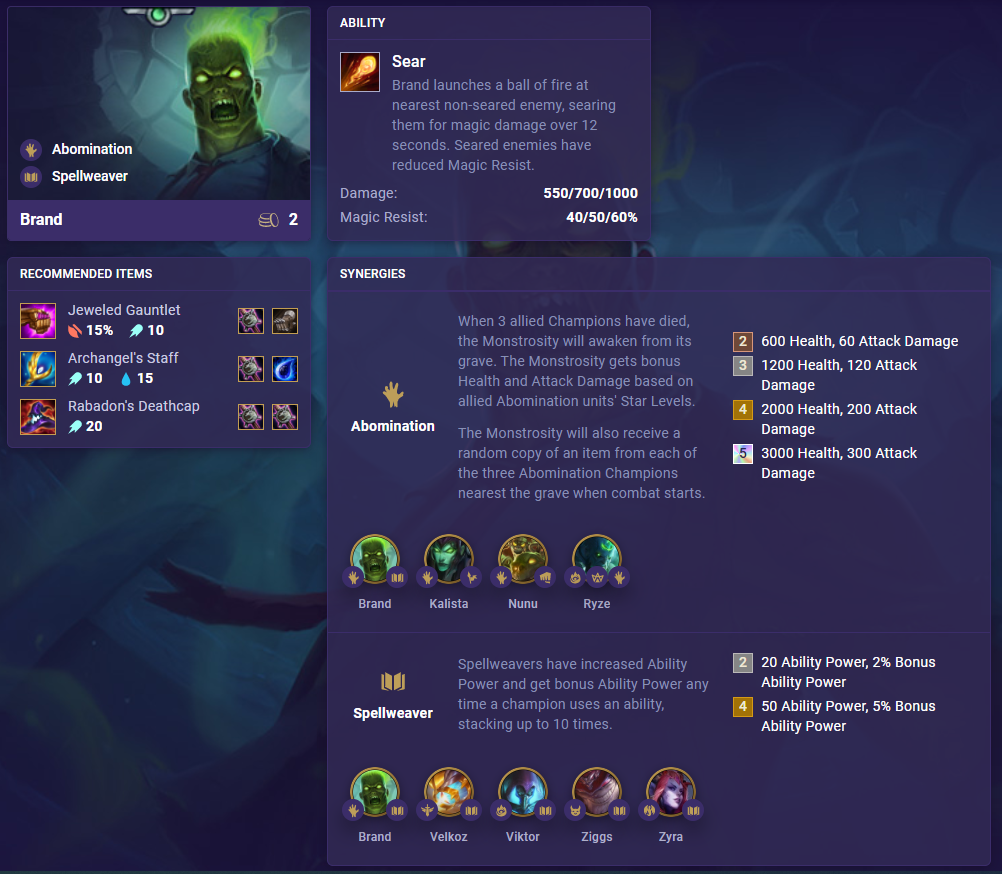
[See Brand’s TFT champion page]
First Impressions: Brand is similar to Ziggs in that his ability is single target, but there is the extra bonus of reducing the target’s magic resist. This will be helpful for the early game to deal with tanks. As an Abomination unit, there will be interest in 3-starring Brand, so we may see a good amount of him going into the new Set.
Positioning: Backline
Hecarim – Forgotten Cavalier

[See Hecarim’s TFT champion page]
First Impressions: Hecarim has the same ability as he did previously, but I like him a little bit better now that he has the Cavalier trait. This will allow him to charge at enemies. This is important since his ability range is quite short and he can waste time walking around the board instead of dealing damage.
Positioning: Frontline
Kennen – Hellion Skirmisher
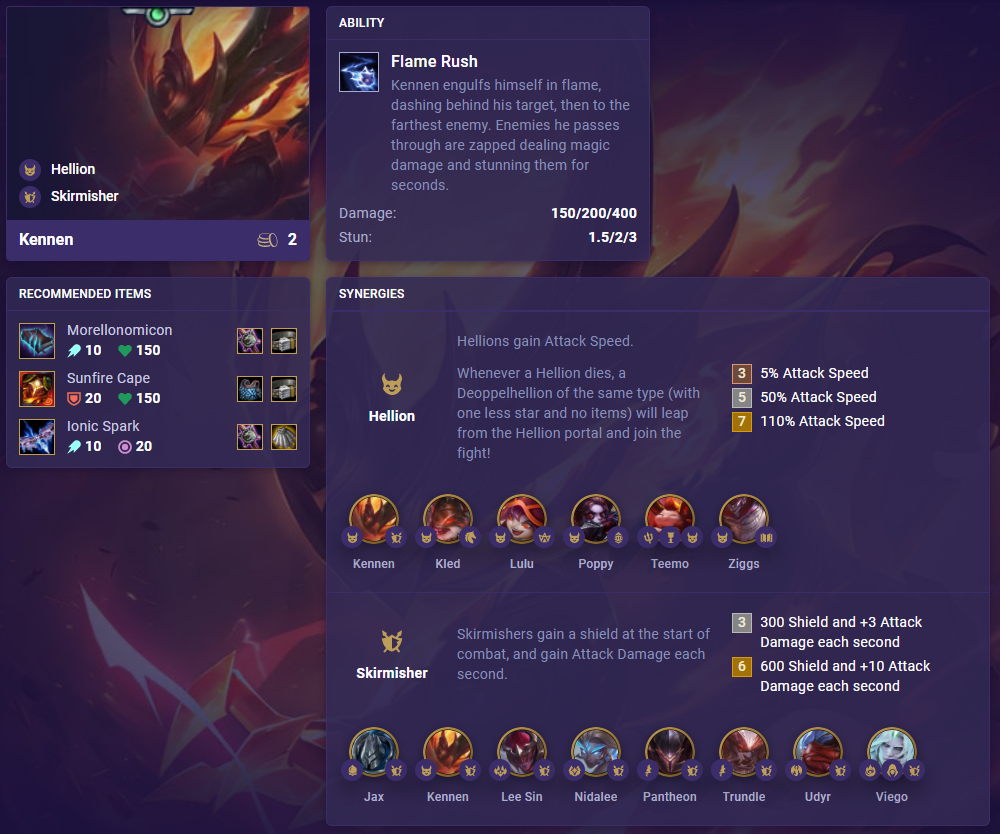
[See Kennen’s TFT champion page]
First Impressions: Kennen is essentially the new Pyke. His ability is very similar in that he stuns units in a line, but he will likely take just a bit longer to finish his ability. He’s definitely a unit that will see play in the late game in Hellion or Skirmisher teams due to his kit providing utility. This makes him a good unit to pair with your main carry that is either a Skirmisher or Hellion.
Positioning: Midline
Leblanc – Coven Assassin
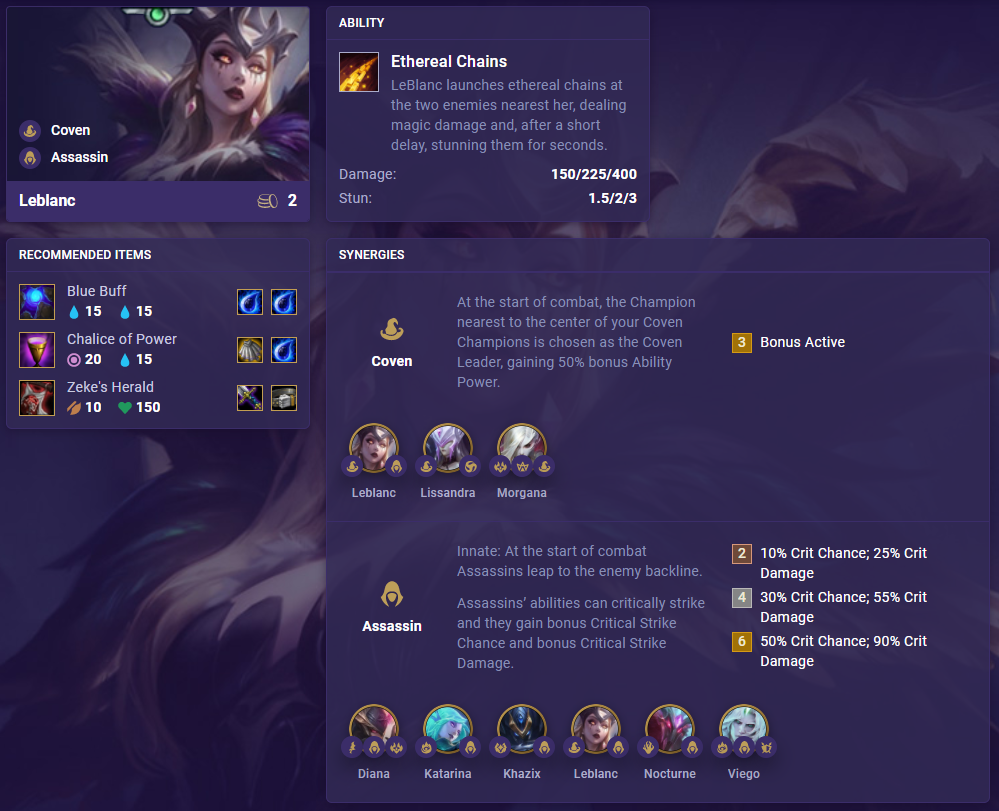
[See Leblanc’s TFT champion page]
First Impressions: Leblanc is unique because she provides CC as an Assassin. Much like Kennen, she will likely stick around in the late game as she does well as a unit to provide bonus traits. Having CC allows players to not have to invest in her items and allows her to benefit the team with her kit. Make sure to place her well as her ability targets the units that are closest to her.
Positioning: Backline
Nautilus – Ironclad Knight
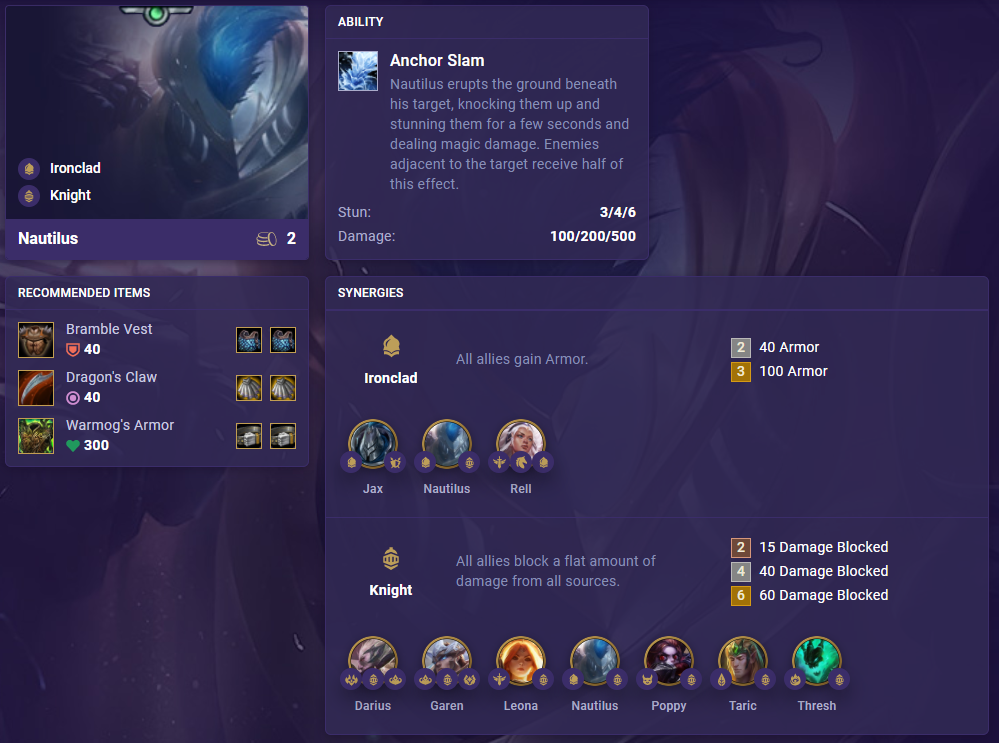
[See Nautilus’ TFT champion page]
First Impressions: There isn’t anything too crazy about Nautilus. He is a solid frontline unit that provides CC and decent damage. Nautilus is quite annoying to play against if your comp is mostly melee. Since his ability is AoE, if he casts multiple times, your melee carry can be stalled for quite a bit of time.
Positioning: Frontline
Sejuani – Nightbringer Cavalier
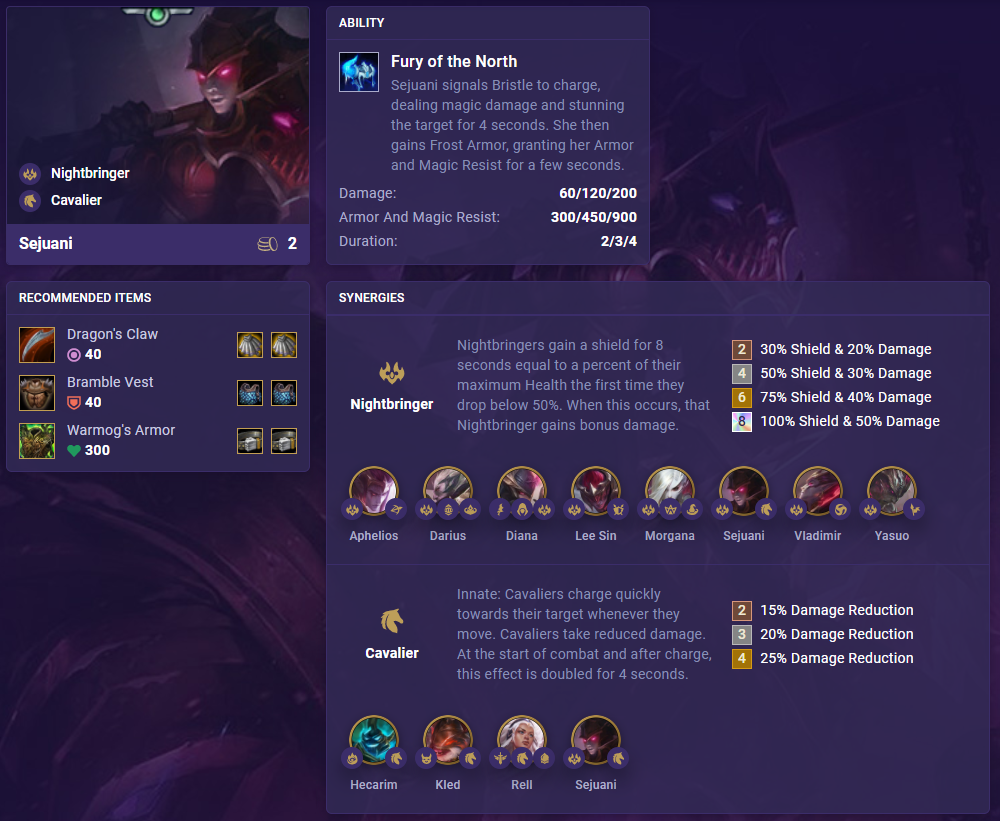
First Impressions: Sejuani isn’t a super special unit. She is very tanky with her ability on and she has a single target stun, which is solid for a two cost unit. Cavaliers seem to provide decent frontline for cheap with units like Sejuani and Kled, but I would imagine theyre a bit less tanky than Knights. However, they likely make up for it in damage.
Positioning: Frontline
[See Sejuani’s TFT champion page]
Sett – Draconic Brawler
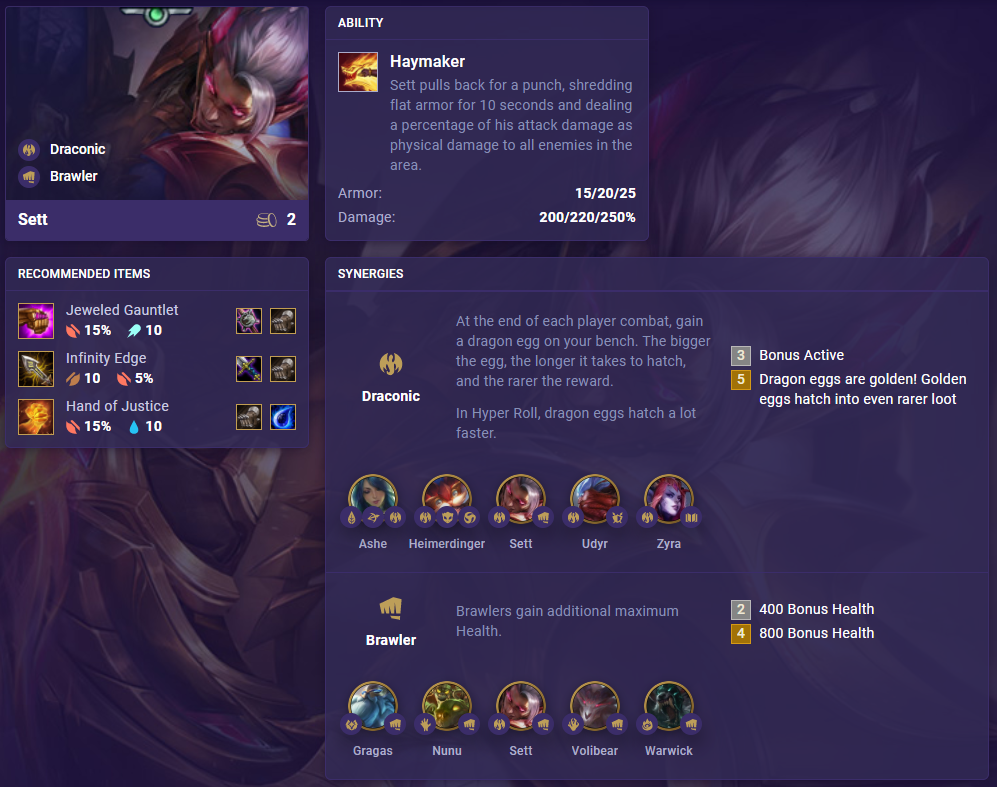
First Impressions: Sett is very similar to Vi from last Set. He is a 2-cost Brawler that has an armor shred in his ability. This will be useful for attack damage teams early on to get through enemy frontlines. I expect players are more interested in running him for his Draconic trait, which is like the new Fortune for Set 5.
Positioning: Frontline
[See Sett’s TFT champion page]
Soraka – Dawnbringer Mystic
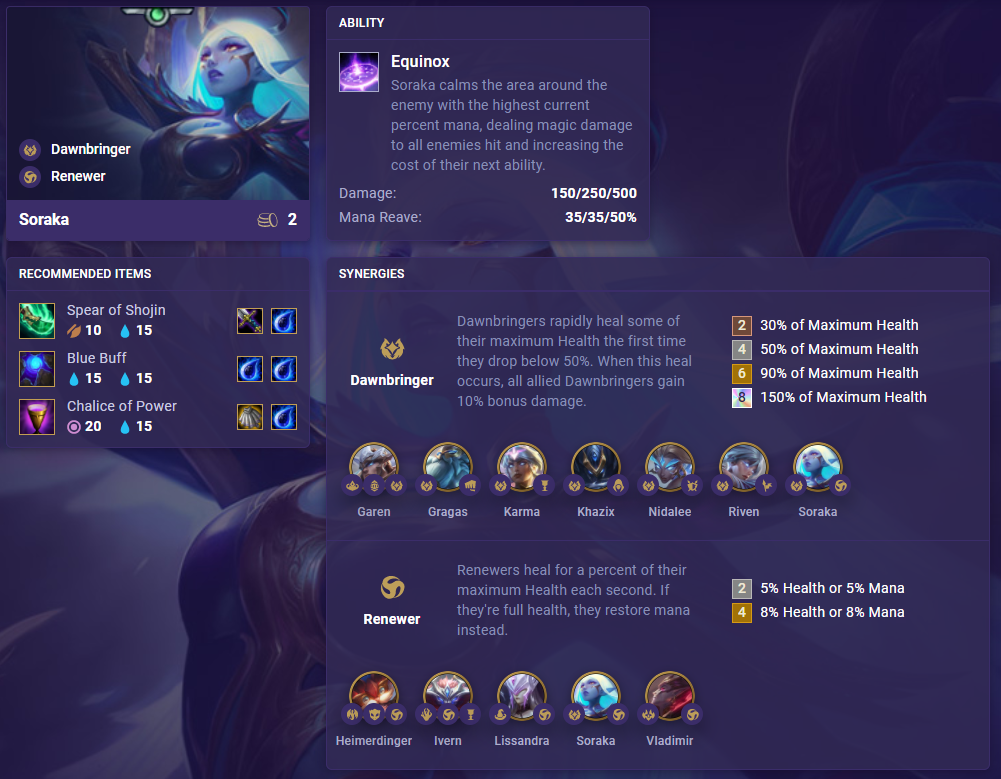
First Impressions: Soraka is another great Mystic unit with a solid ability. She can come in clutch by delaying an important spell cast from an enemy. The only problem is you can’t really control who she casts on, it’s entirely dependent on who has the most mana when she casts. Even still, I can see this ability being very useful in fights.
Positioning: Backline / Midline
[See Soraka’s TFT champion page]
Syndra – Redeemed Invoker
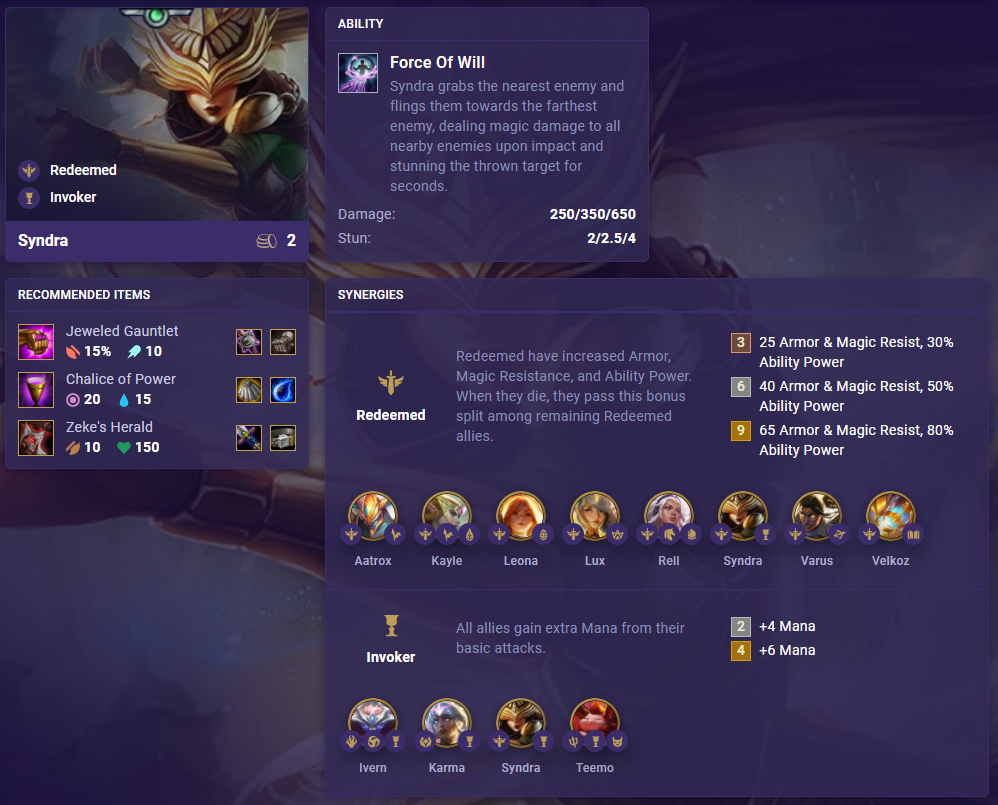
First Impressions: In my mind, Syndra is the early game item holder for a late game carry like Karma or Teemo. Her ability not only deals solid damage, but it is also AoE and provides CC. For only a two cost unit, that’s pretty good.
Positioning: Backline
[See Syndra’s TFT champion page]
Thresh – Forgotten Knight
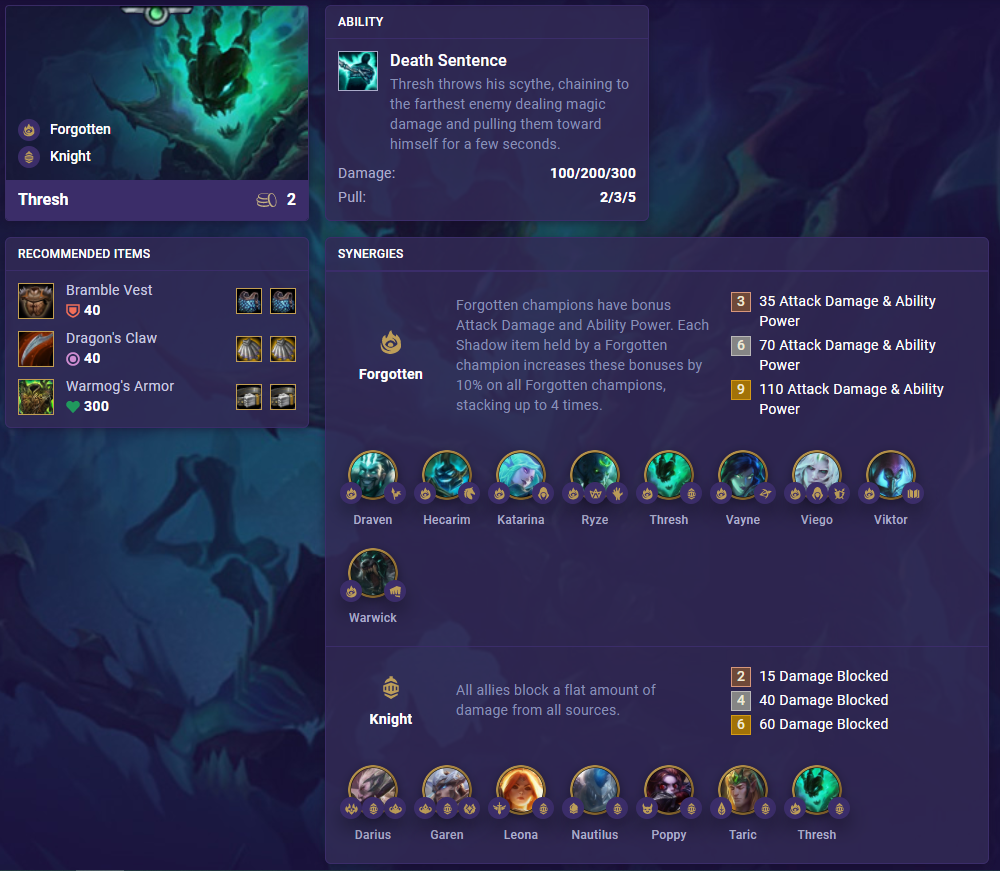
First Impressions: Thresh plays the role of the Blitzcrank or Aatrox. If I am correct, his ability does not hit the first unit it collides with and instead will always hit the furthest target. This will mean that you won’t want to put your main carry in the corner against Thresh, as he will hook them with his ability. A unit like this is important for Set 5 as it creates more situations to position around. Make sure to try and position him on the side where he will hook a more important unit.
Postioning: Frontline
[See Thresh’s TFT champion page]
Trundle – Dragonslayer Skirmisher
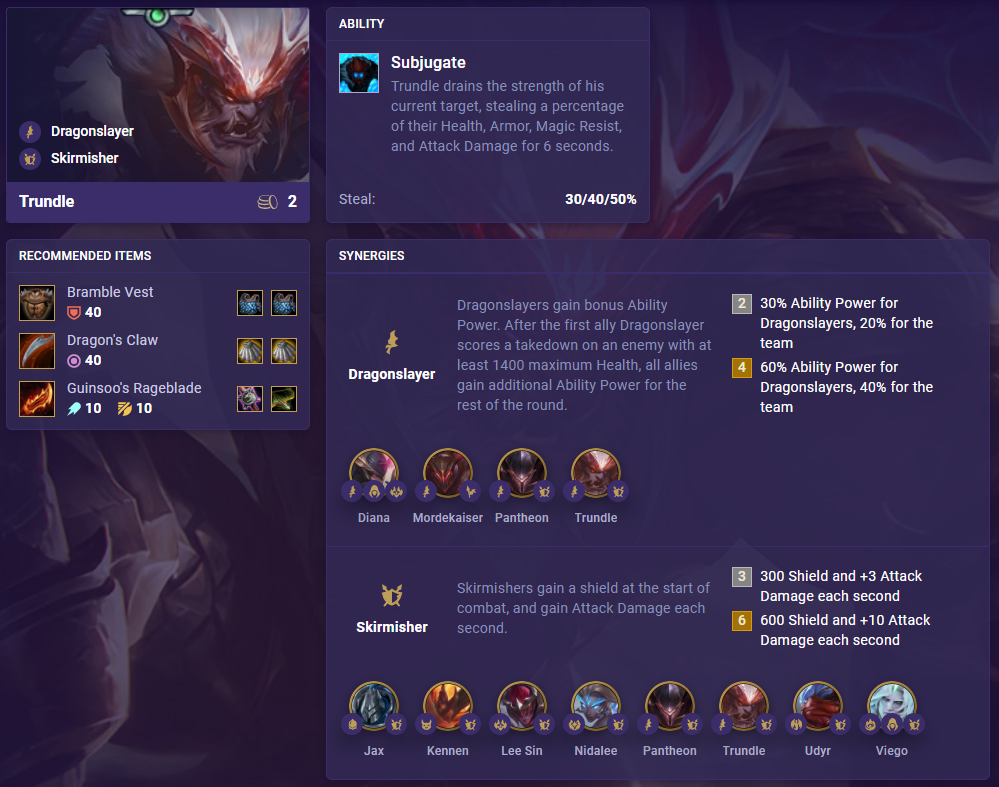
[See Trundle’s TFT champion page]
First Impressions: Trundle is an interesting unit. His ability steals stats from his target, so that makes him a very tanky unit, but it also makes the enemy less tanky. Trundle will be great for dealing with tanky enemies, while also possibly becoming a tanky monster himself. Try to position him in front of an enemy with high stats to get the most out of his ability.
Positioning: Frontline
Varus – Redeemed Ranger
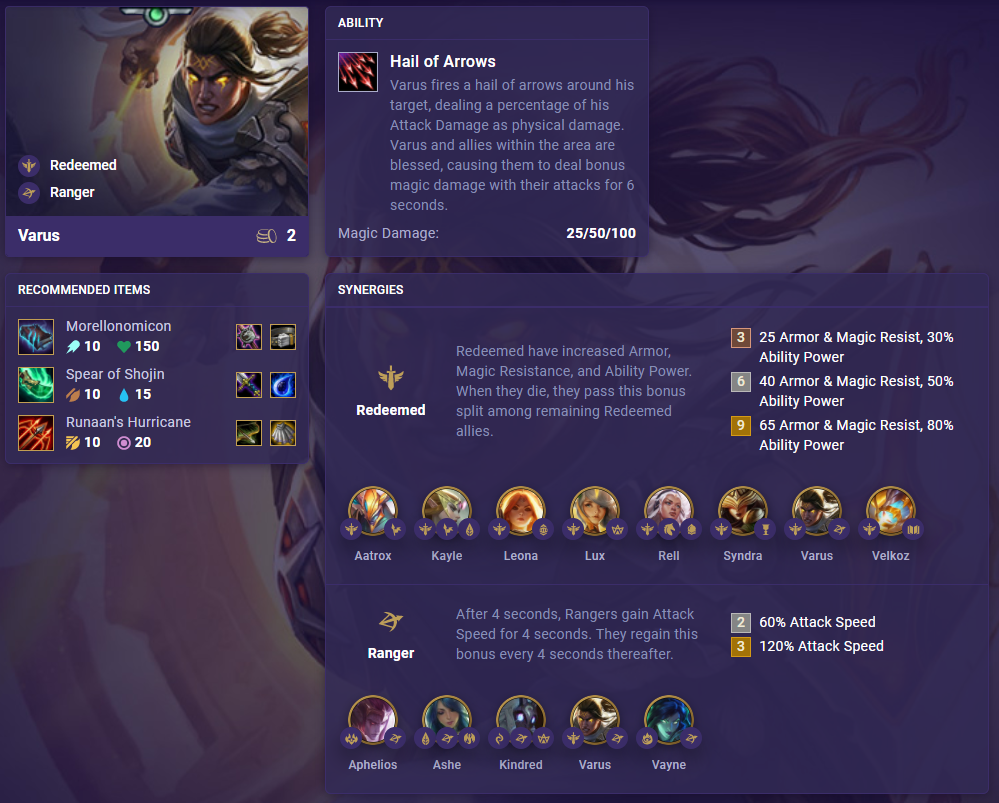
[See Varus’s TFT champion page]
First Impressions: Varus is back as a Ranger, but his ability is now his E from League of Legends rather than his Q. The interesting point about Varus is that he deals physical damage with his ability, which isn’t very common with abilities that aren’t attacks. This pairs nicely with Rangers as the expected combo of Statikk Shiv will provide a lot of magic damage.
Positioning: Backline
Viktor – Forgotten Spellweaver
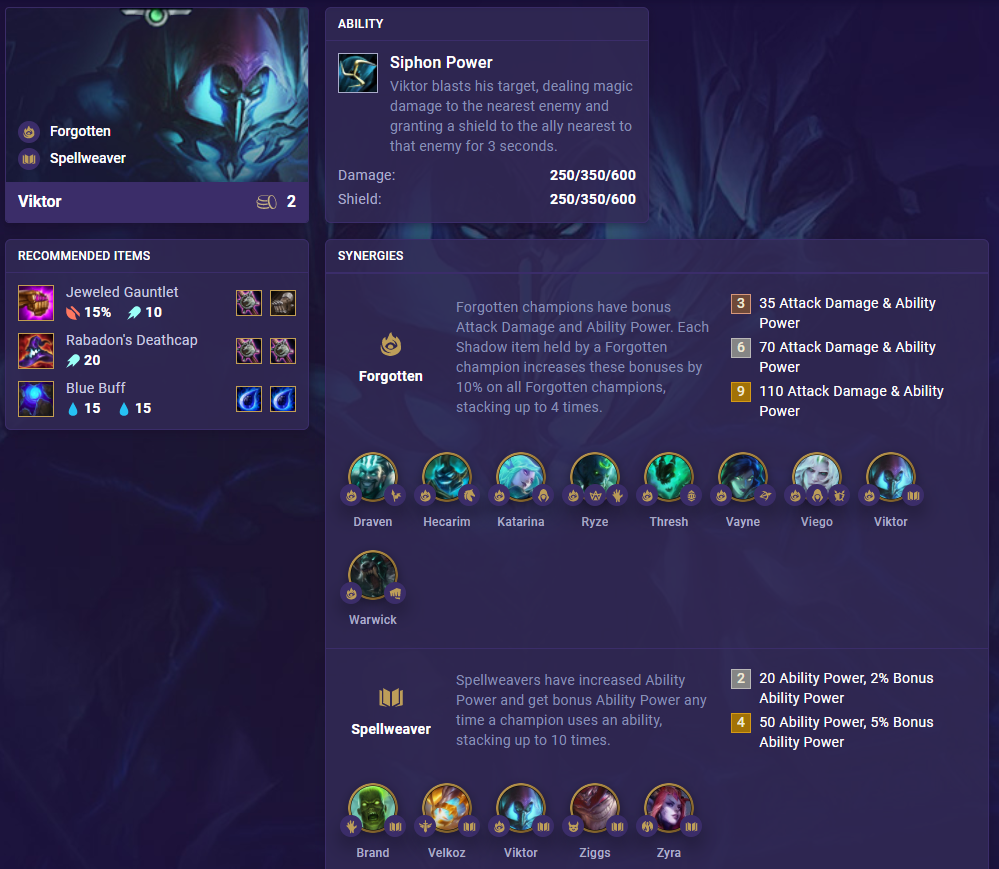
[See Viktor’s champion page]
First Impressions: Viktor is another Spellweaver that has a single target ability. Spellweavers worry me for the early game simply because all of their abilities are single target. Even still, granting a shield is a nice addded effect for a 2-cost unit.
Positioning: Backline
3-Cost Champions
Ashe – Verdant Draconic Ranger 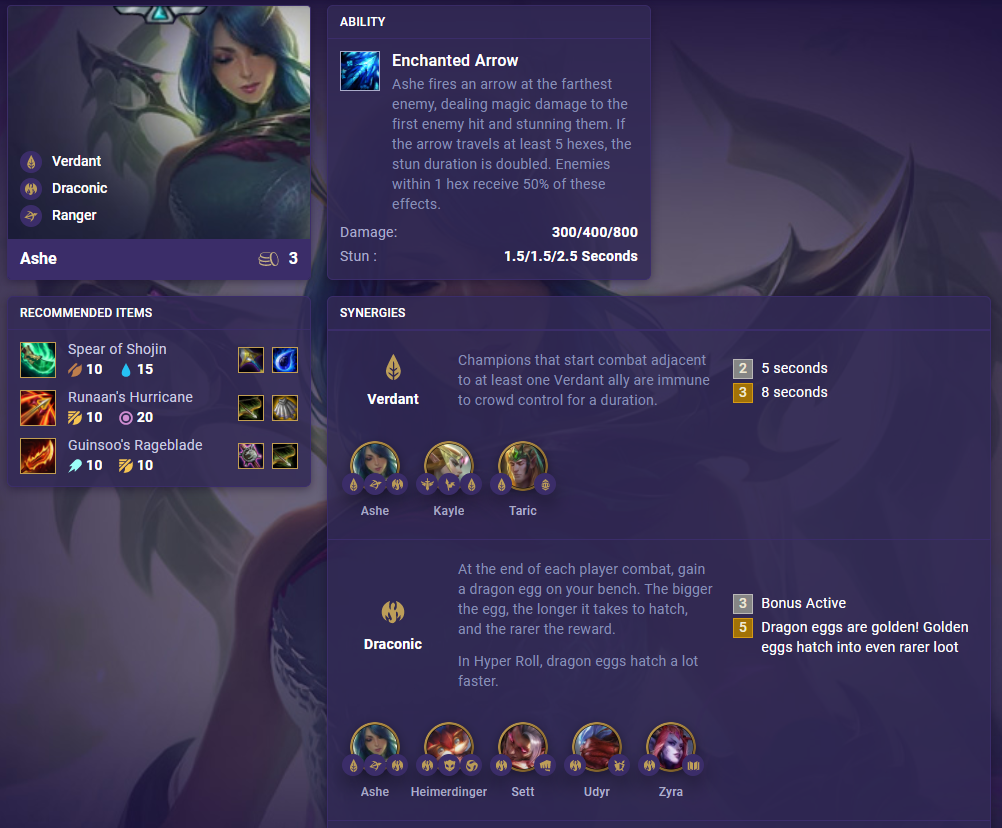
[See Ashe’s TFT champion page]
First Impressions: Ashe is back with her ultimate from League. Her ability stuns for a solid amount of time assuming the arrow travels at least 5 hexes. Her attack speed from Rangers makes her a perfect unit to hold Spear of Shojin.
Positioning: Backline corner
Katarina – Forgotten Assassin
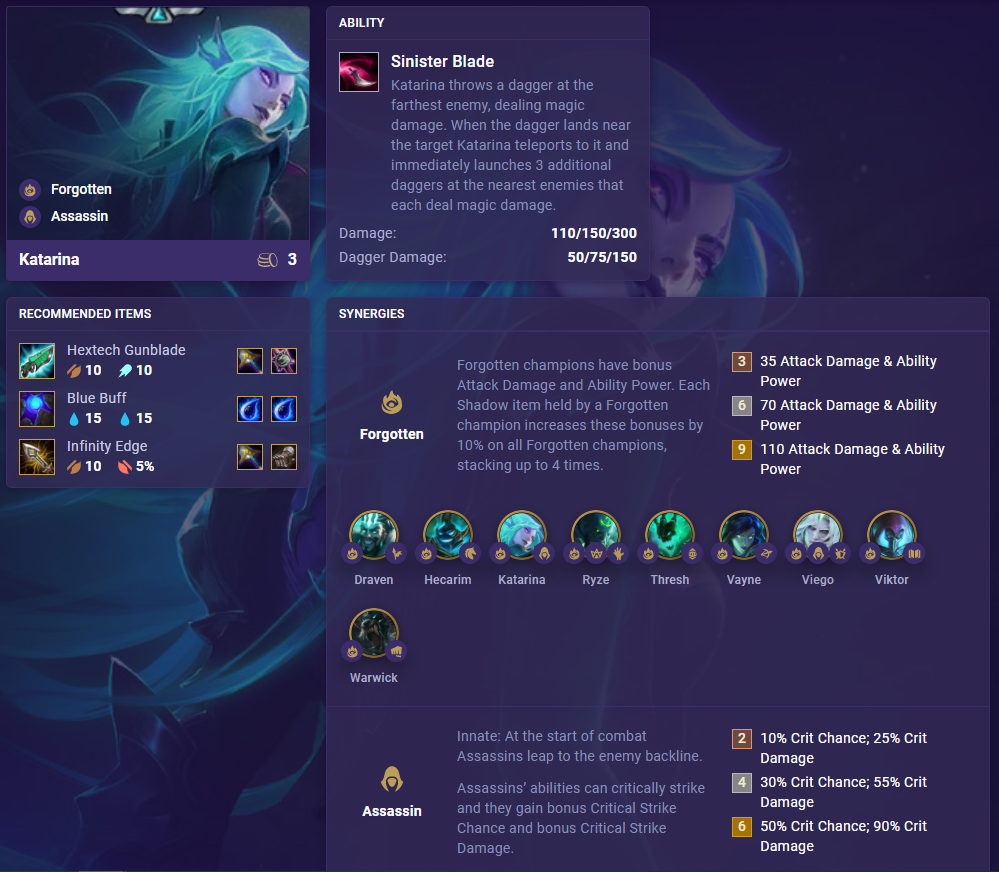
[See Katarina’s TFT champion page]
First Impressions: Katarina is an Assassin that has mobility and solid damage. She may be quite annoying to deal with if she is constantly teleporting around the board.
Positioning: Backline
Lee Sin – Nightbringer Skirmisher
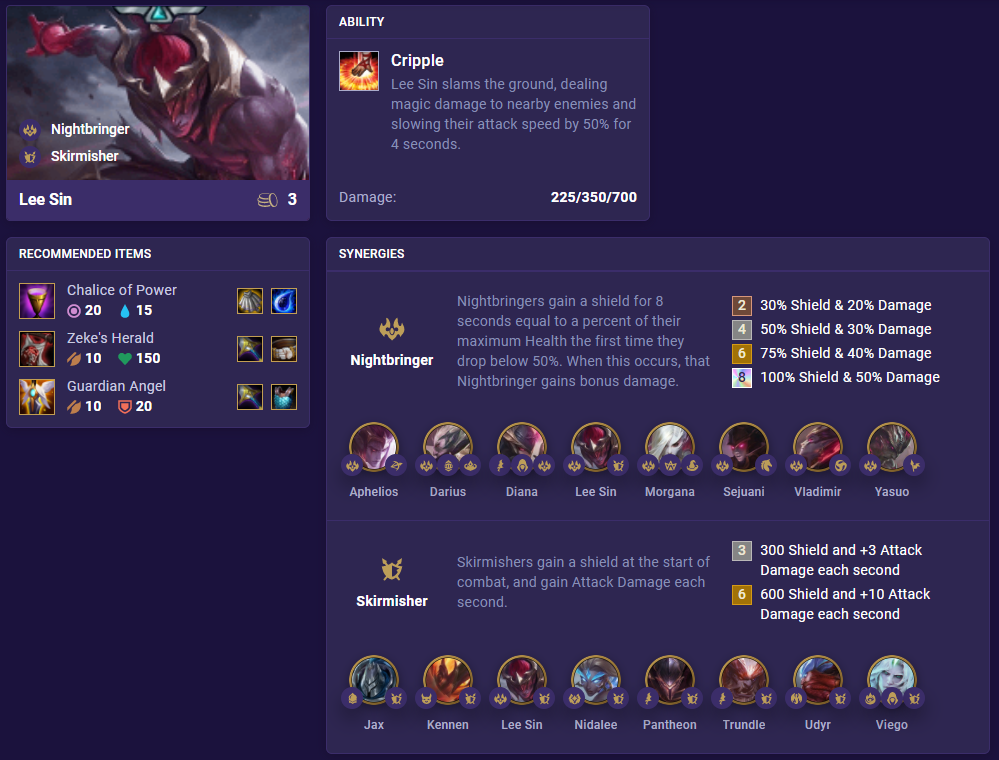
[See Lee Sin’s TFT champion page]
First Impressions: Lee Sin seems like a decent unit, but I worry that his ability will mainly hit frontline units rather than enemy carries. If the enemy is running a melee carry, make sure to place Lee Sin close by so that his ability can slow the enemy carry’s attack speed.
Positioning: Frontline
Lulu – Hellion Mystic
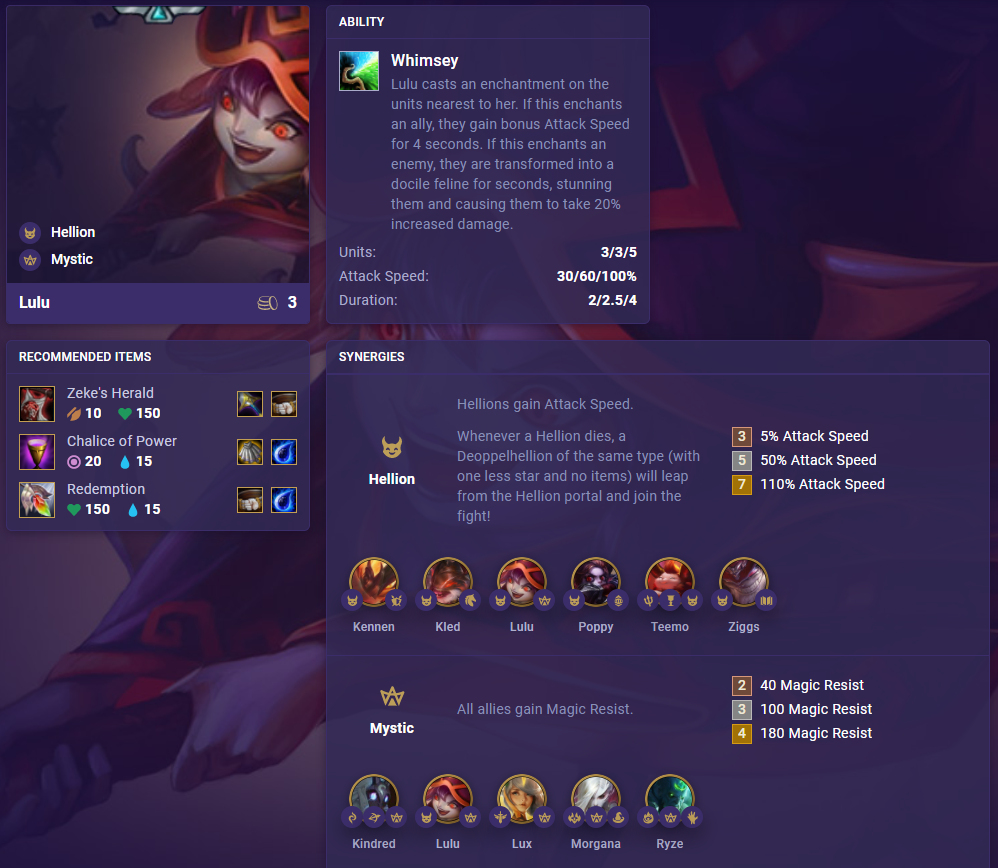
[See Lulu’s TFT champion page]
First Impressions: Lulu is back, and this time, her ability can either buff or debuff enemies. If you want Lulu to debuff an enemy, try to place her close to the enemy you want to debuff and away from allies. Even if you can’t safely do so, the bonus attack speed give to allies is also a strong and flexible ability to fit in many teams. Being a Mystic unit also makes her extremely flexible in team comps as well.
Positioning: Midline
Lux – Redeemed Mystic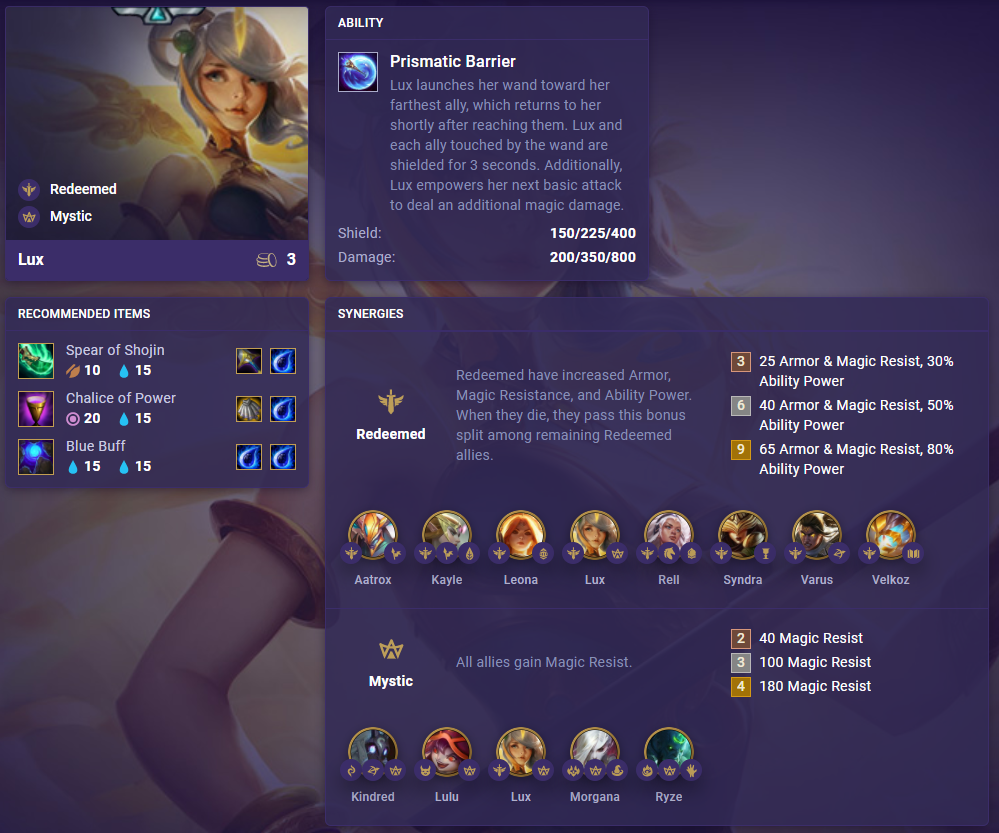
[See Lux’s TFT champion page]
First Impressions: Lux is another example of a solid Mystic unit that can be splashed into many team comps. Redeemer comps will have easy access to 2 Mystic with Lux. Her shield is nice, but I think other units like Lulu and Ryze provide better utility compared to Lux. Even still, she’s bound to be a solid unit for any comp running Redeemers.
Positioning: Backline Corner
Morgana – Nightbringer Coven Mystic
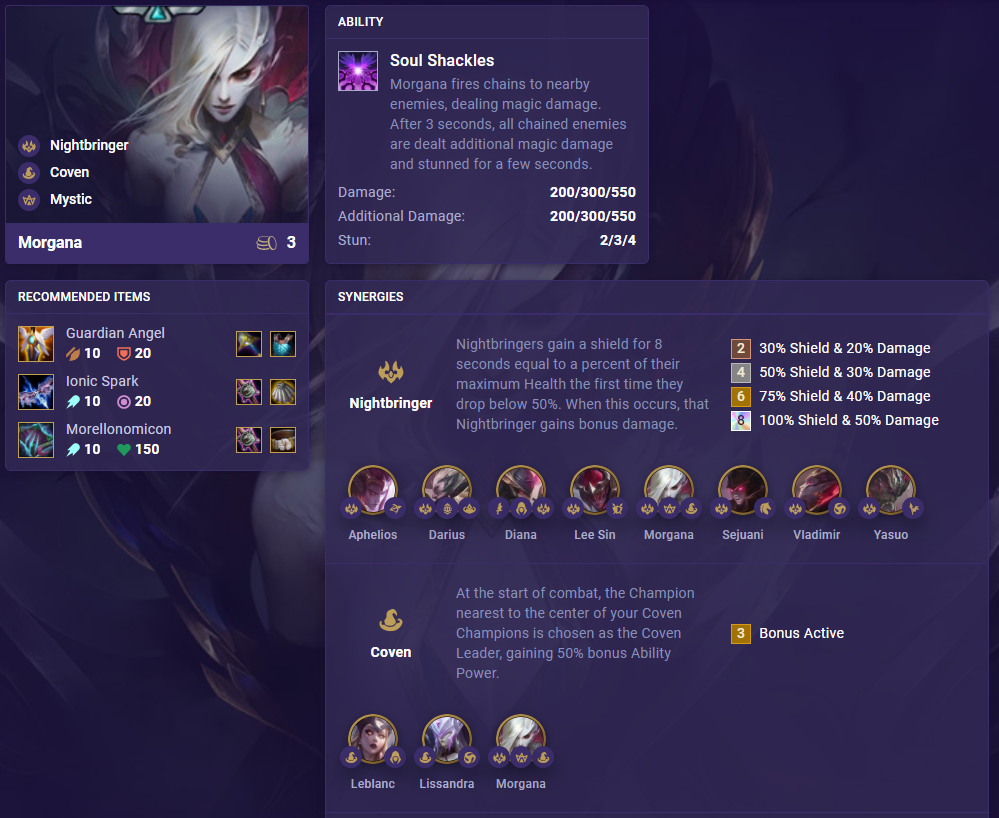
[See Morgana’s TFT champion page]
First Impressions: Morgana is back but this time with a different ability. You may be tempted to place her in the back like a ranged unit, but she will likely do best in the front where she can hit many units with her ability. Since she is a Nightbringer, she has built in survivability which should help her cast her ability before dying. You can also use an item like Guardian Angel to ensure she casts her ability.
Positioning: Frontline
Nidalee – Dawnbringer Skirmisher
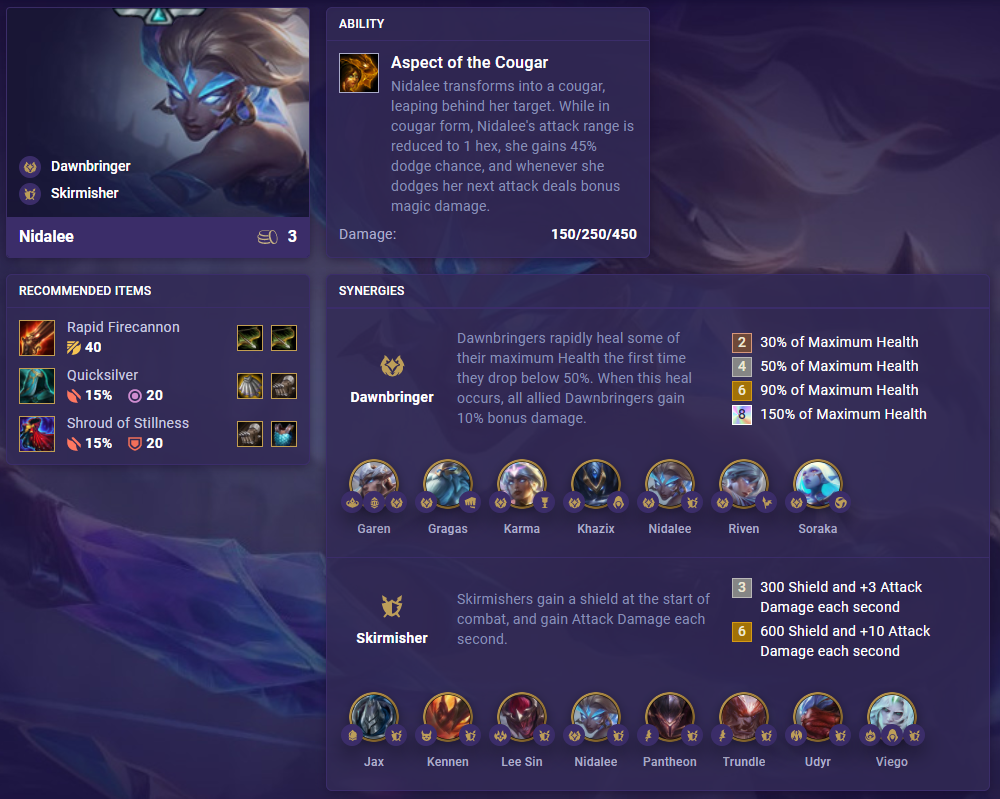
[See Nidalee’s TFT champion page]
First Impressions: Nidalee is an interesting unit. She transforms in to a cougar with with 1 range, and she scales better with Dodge. This makes her a solid item holder for things like Quicksilver which give Dodge. However, Rapid Firecannon almost completely counters Dodge, so I don’t expect her to ever break the meta with some Dodge build.
Positioning: Backline
Nocturne – Revenant Assassin
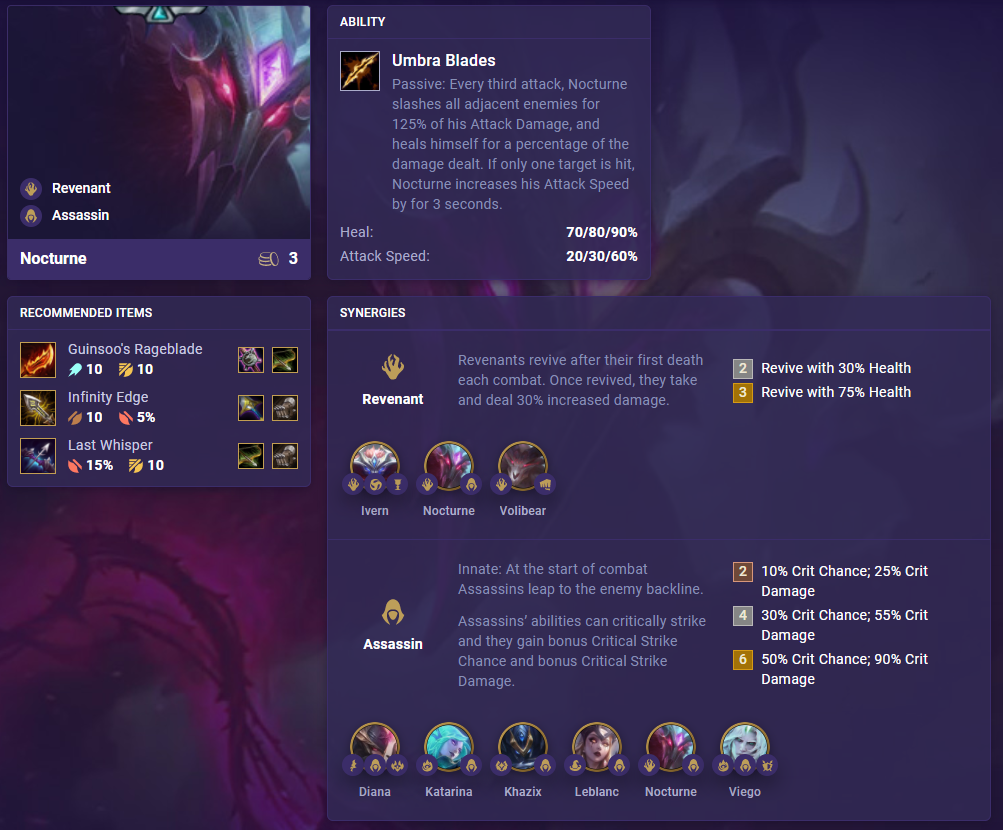
[See Nocturne’s TFT champion page]
First Impressions: Nocturne is quite the scary Assassin since he has built in lifesteal. This lets you really go into building offensive items. Furthermore, since he is a Revenant, he has built in Guardian Angel if you are able to fit in at least one other Revenant. He will deal and take more damage, but since he has built in lifesteal, this ends up still working in Nocturnes favor.
Positioning: Backline
Nunu – Abomination Brawler
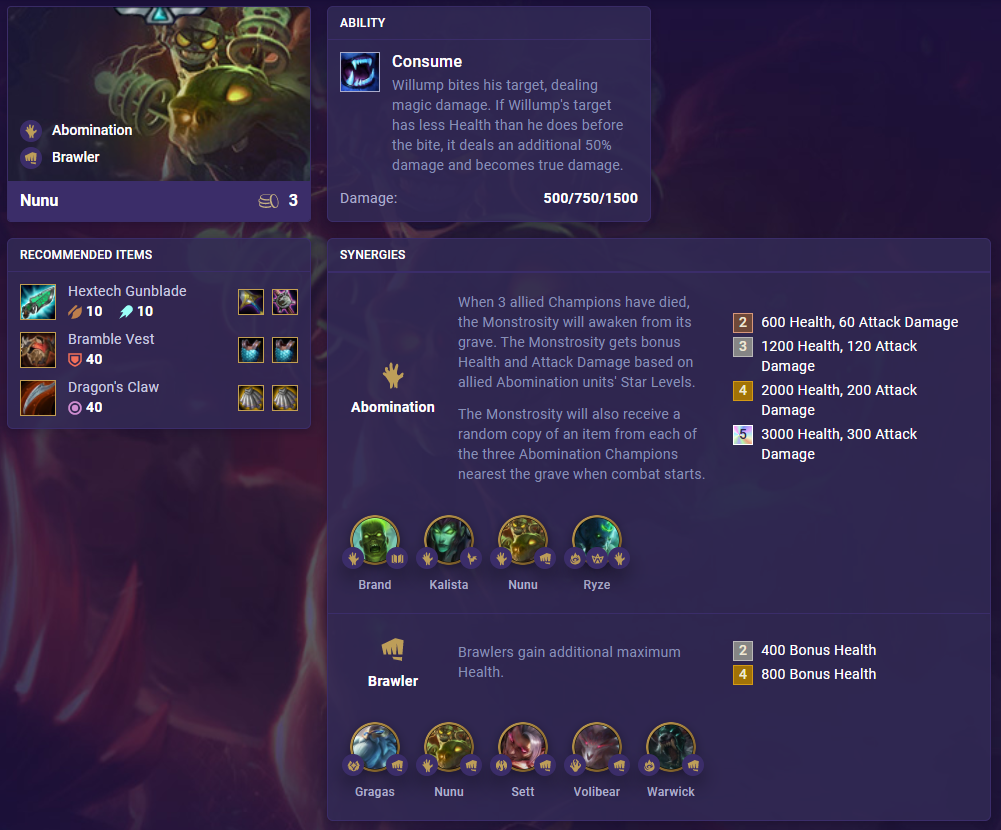
[See Nunu’s TFT champion page]
First Impressions: Nunu is the frontline unit in the Abomination lineup. Since the Abomination gains a random item from your Abomination units, you may not want to stack more than one item on Nunu. Splitting your ideal Abomination items up might be the play for this type of team comp.
Positioning: Frontline
Pantheon – Dragonslayer Skirmisher
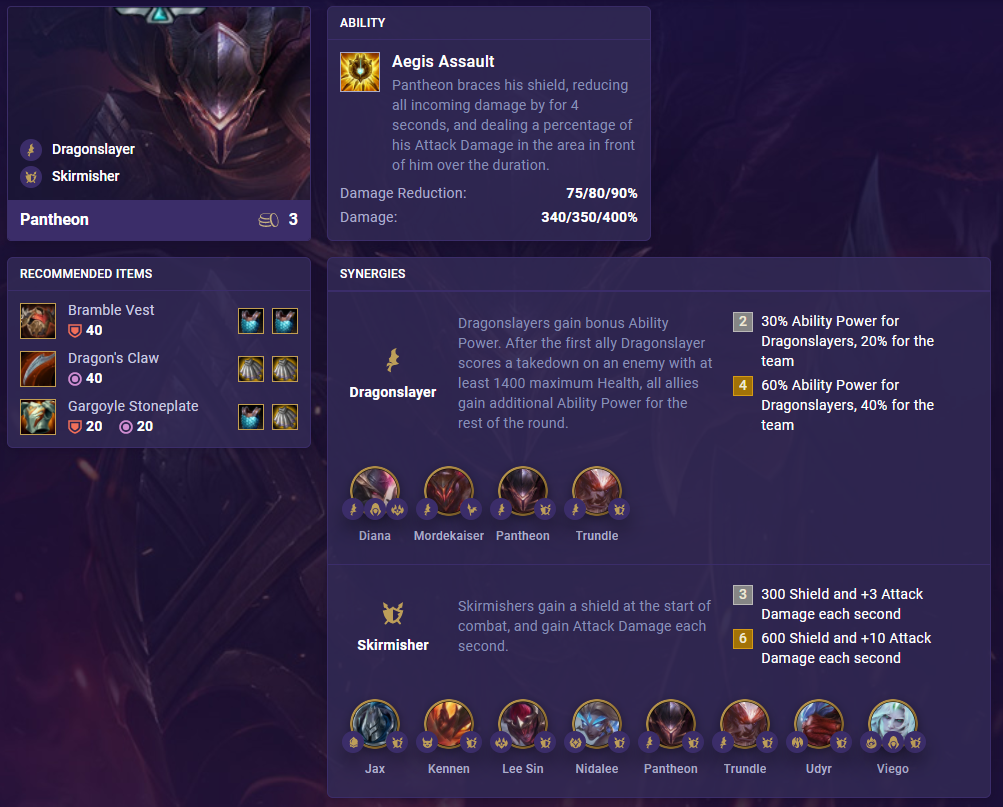
[See Pantheon’s TFT champion page]
First Impressions: At first glance, Pantheon seems to be an amazing unit at stalling. However, this will depend on how large his mana pool is. If it’s not too big, Pantheon can be one of the best tanks on a Skirmisher team, stalling the fight out for more damage to be built up by Skirmishers.
Positioning: Frontline
Riven – Dawnbringer Legionnaire
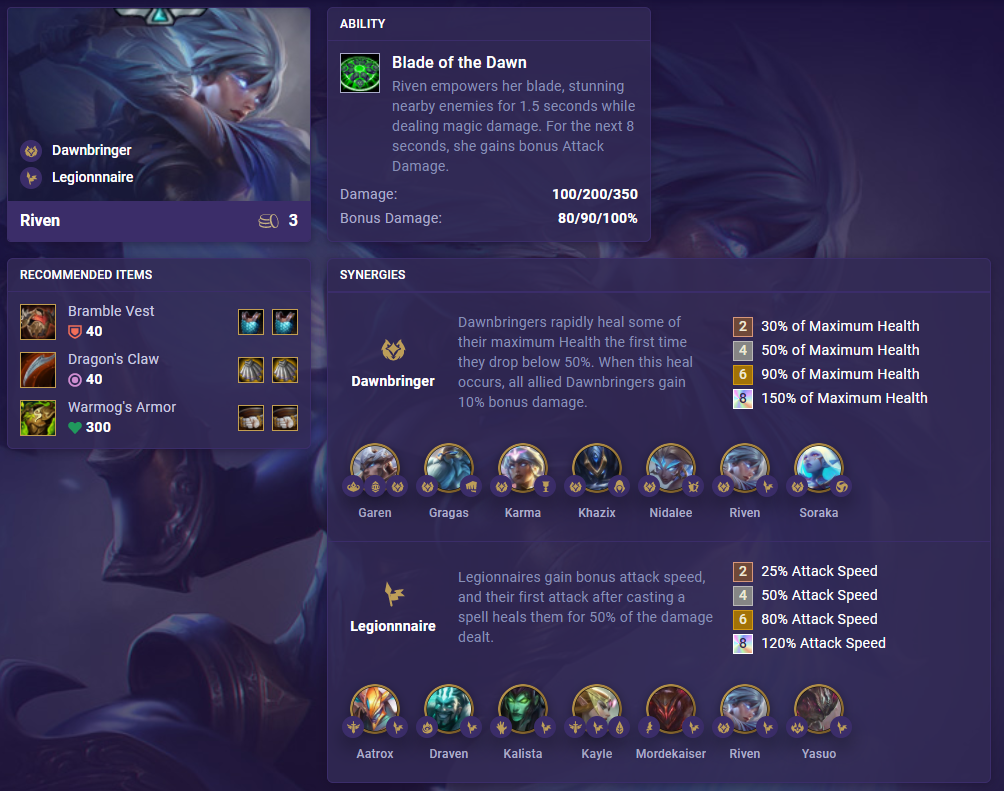
[See Riven’s TFT champion page]
First Impressions: Riven seems to be a semi tank for Legionnaire or Dawnbringer teams. Her ability provides some decent damage, so it may be enough to only need defensive items on Riven. She likely won’t be the main carry on a team, but she can be a solid unit to place extra items on.
Positioning: Frontline
Yasuo – Nightbringer Legionnaire
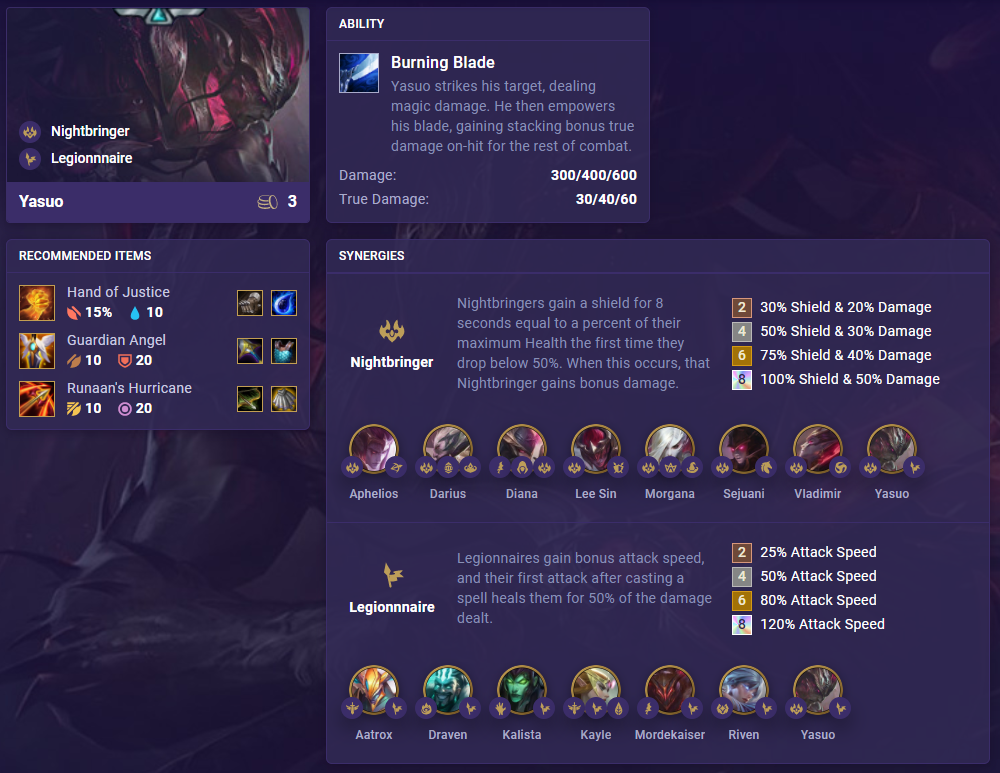
[See Yasuo’s TFT champion page]
First Impressions: Yasuo seems to be a solid main carry to me. He gains true damage throughout the fight, and has built in lifesteal through Legionnaire. Items like Hurricane will be great to spread his on hit true damage to multiple units.
Positioning: Midline
Zyra – Draconic Spellweaver
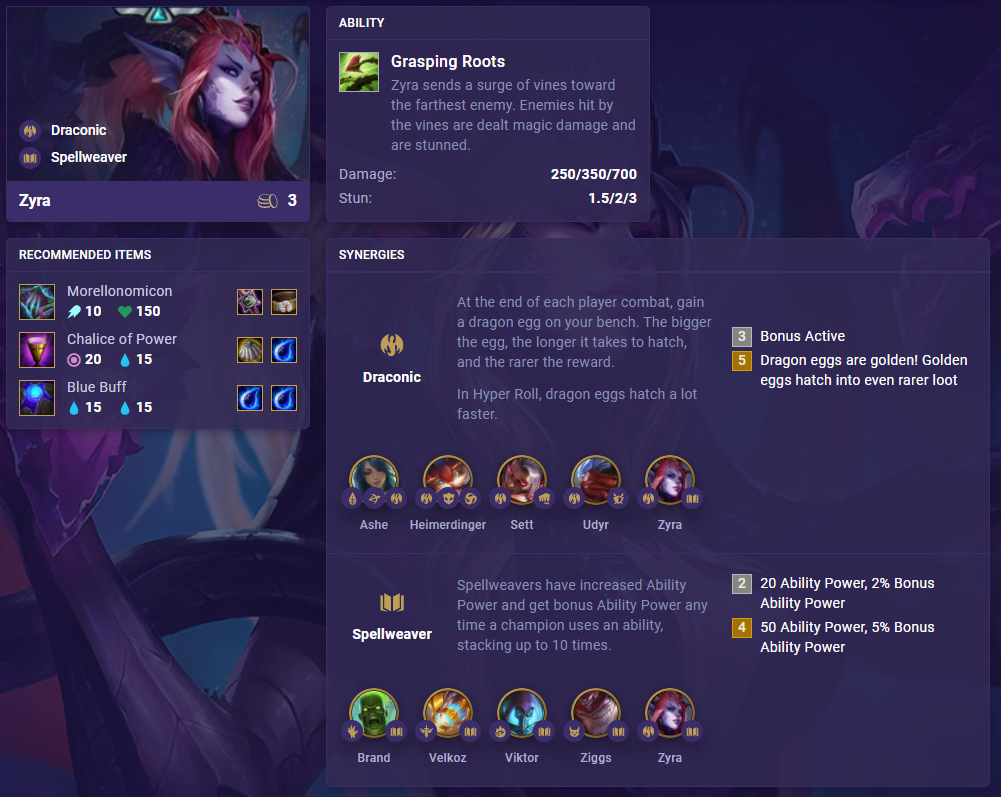
[See Zyra’s TFT champion page]
First Impressions: Zyra is the utility unit for Spellweavers. This is the only AoE damage in the Spellweaver trait that’s 3-cost or below. Because of this, I can see Spellweavers struggling early without ample frontline. Like Ashe, she targets the furthest enemy, so you will want to place her in one of the corners to try and hit as many units as possible.
Positioning: Backline Corner
4-Cost Champions
Aphelios – Nightbringer Ranger
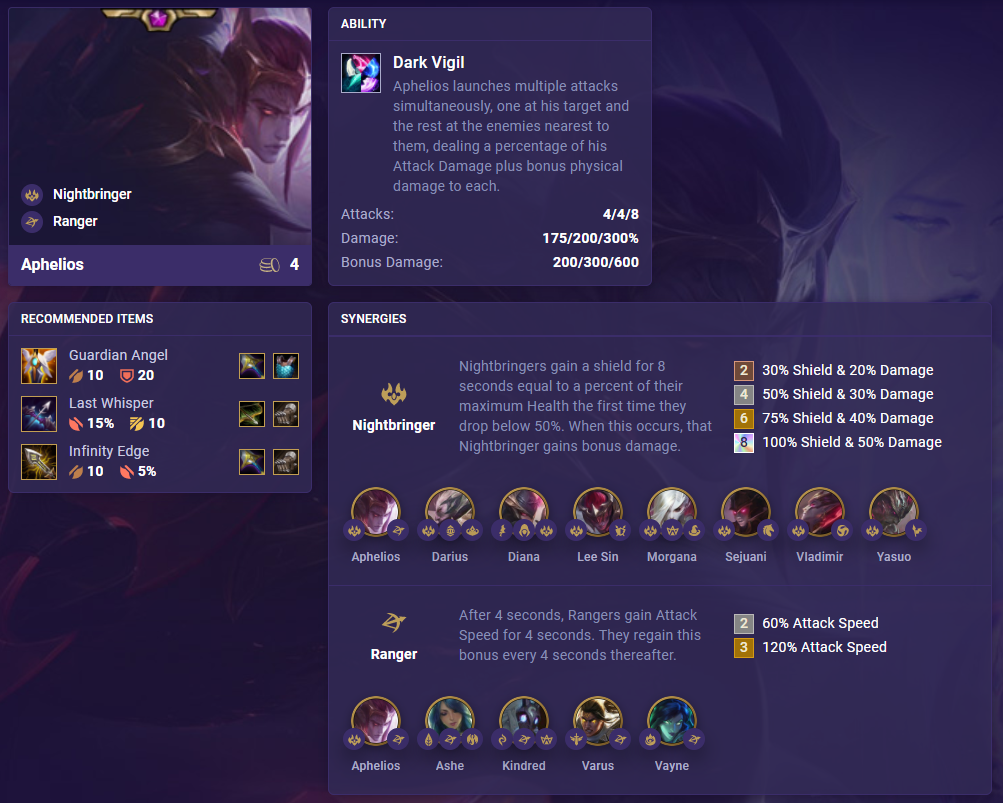
[See Aphelios’s TFT champion page]
First Impressions: Aphelios is clearly an attack damage hyper carry for Rangers. His ability provides a lot of physical damage, which can pair nicely with other units that provide magic damage through Statikk Shiv. Aphelios provides a different carry for Ranger comps that build more Nightbringer units instead of things like Redeemer or Statikk Shiv stacking.
Positioning:
Diana – Dragonslayer Nightbringer Assassin
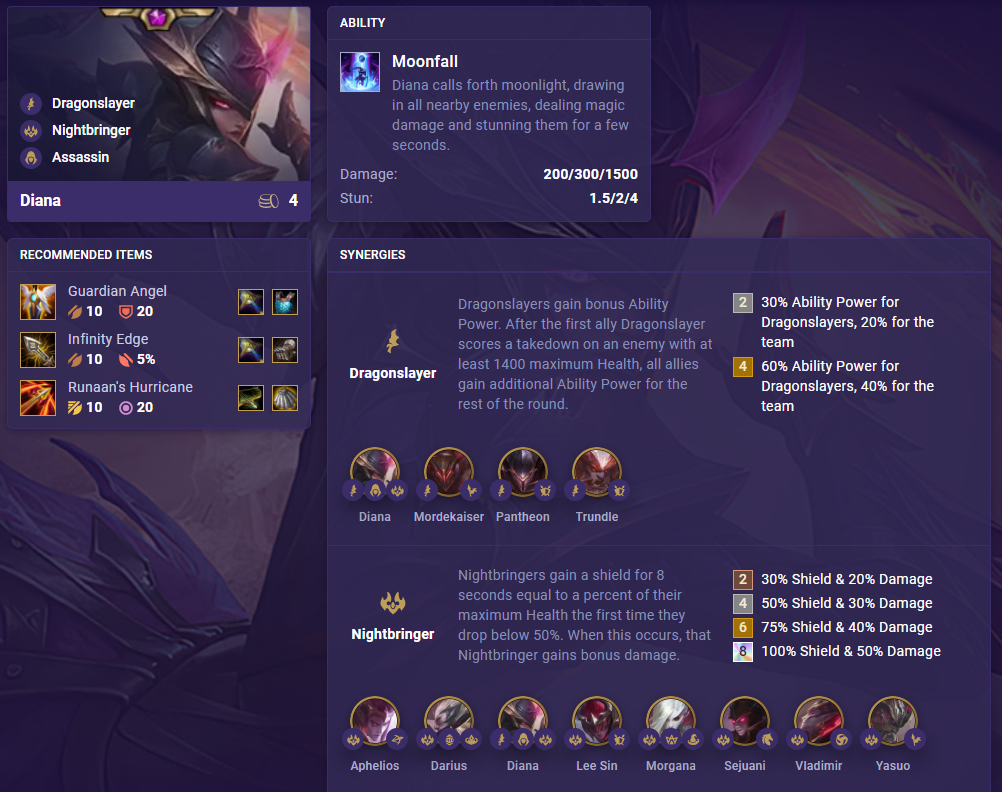
[See Diana’s TFT champion page]
First Impressions: Diana looks to be quite the scary Assassin. Her ability provides AoE CC and she will likely deal a good amount of damage with her auto attacks as well. Being an Assassin allows her spell to crit as well, which will add a nice chunk of damage.
Positioning: Backline
TFT Draven – Forgotten Legionnaire
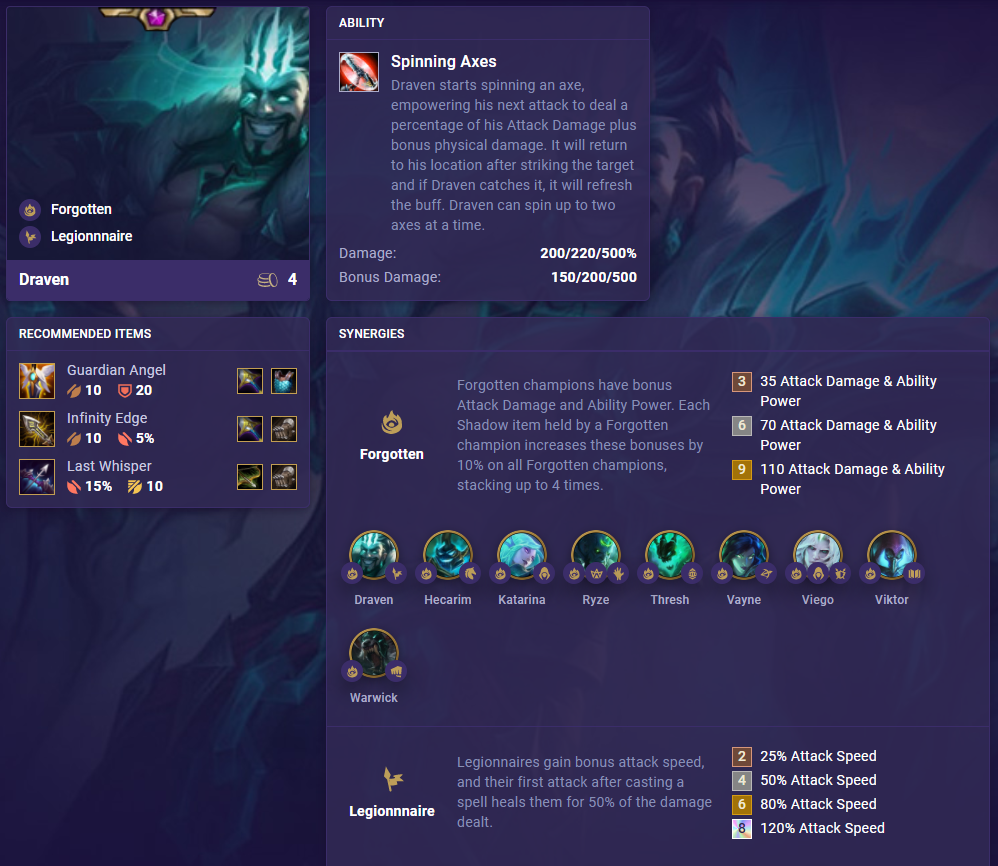
[See TFT Draven champion page]
First Impressions: Draven is back with his trademark spinning axes. Rapid Firecannon was changed to only give +1 Hex range, so we may see Draven players want to build more crit damage items rather than RFC. As usual, being a Legionnaire gives him a little bit of healing, so we’re likely going to see heavily offensive items on Draven.
Positioning: Backline
Ivern – Revenant Invoker Renewer
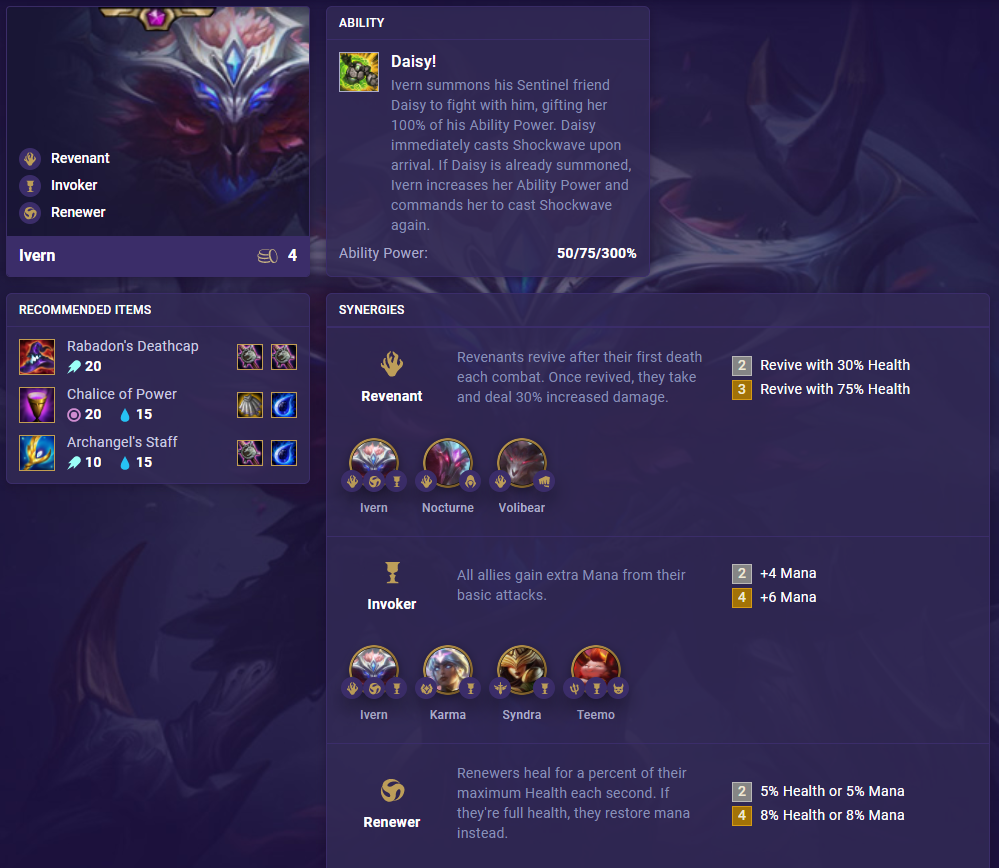
[See Ivern’s TFT champion page]
First Impressions: From the way Ivern’s ability is worded, it seems like he is a unit that will do well with a lot of Ability Power. This will empower Daisy even further, making the shockwave more powerful. He’s also safe to be in the frontline as he is a Revenant and has a built in Guardian Angel as long as the bonus is active.
Positioning: Frontline
Jax – Ironclad Skirmisher
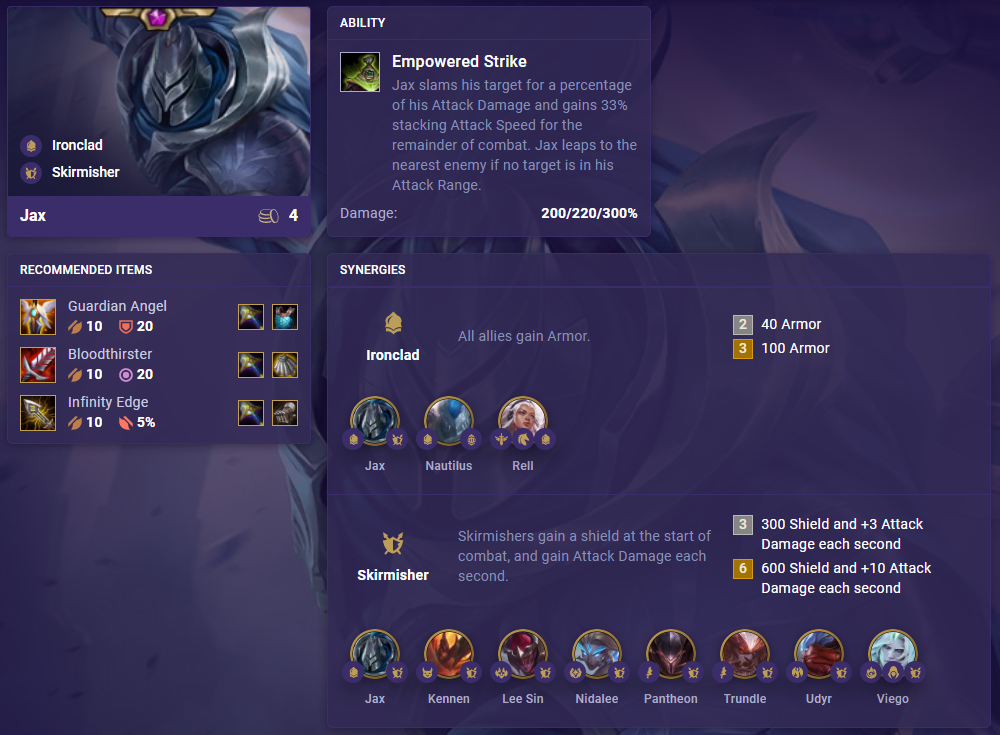
[See Jax’s TFT champion page]
First Impressions: Jax is quite the melee carry. He jumps to enemies and his traits and abilities give him scaling attack damage and attack speed. Keeping Jax alive for as long as possible looks to be the best course of action. Items like Guardian Angel and Bloodthirster will help him stay alive and make his damage extremely strong toward the end of the fight.
Positioning: Midline
Karma – Dawnbringer Invoker
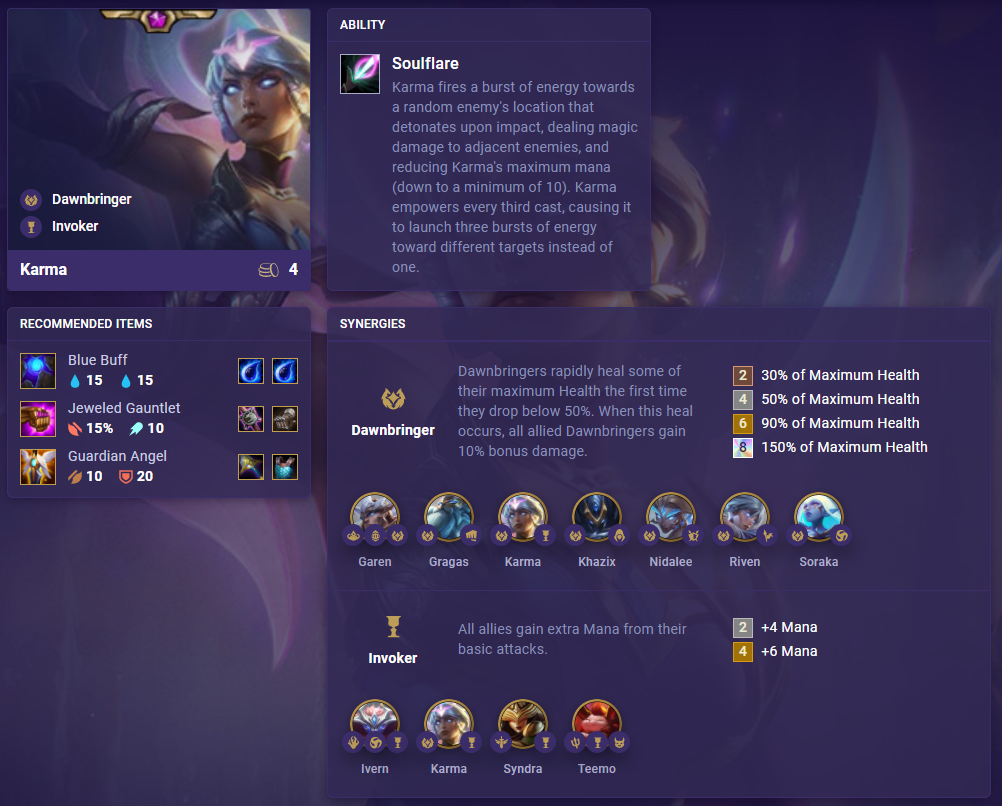
[See Karma’s TFT champion page]
First Impressions: Karma feels like a powerful carry if you are able to stall long enough. She’s similar to Jax in that once she gets going, she will start casting more and more. If the fight lasts long enough, she will have almost no mana and might not even need a mana item like Blue Buff. However, Blue Buff will help reduce her mana cost faster, so it will depend on the situation.
Positioning: Backline
Mordekaiser – Dragonslayer Legionnaire
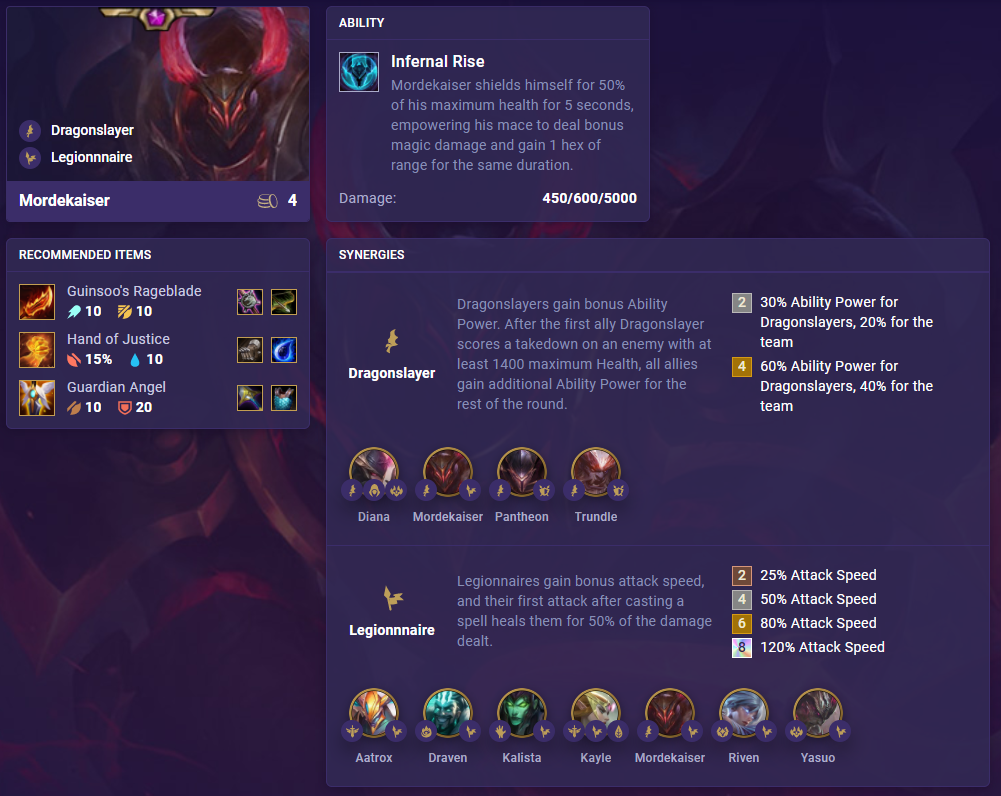
[See Mordekaiser’s TFT champion page]
First Impressions: When Mordekaiser casts his ability, he will gain range and smack enemies with bonus magic damage. Giving him large amounts of attack speed will surely make him into a strong carry. However, if his mana pool is too large or his mana lock duration is too long, he may be a bit clunky to use as your main carry.
Positioning: Midline
Rell – Redeemed Ironclad Cavalier
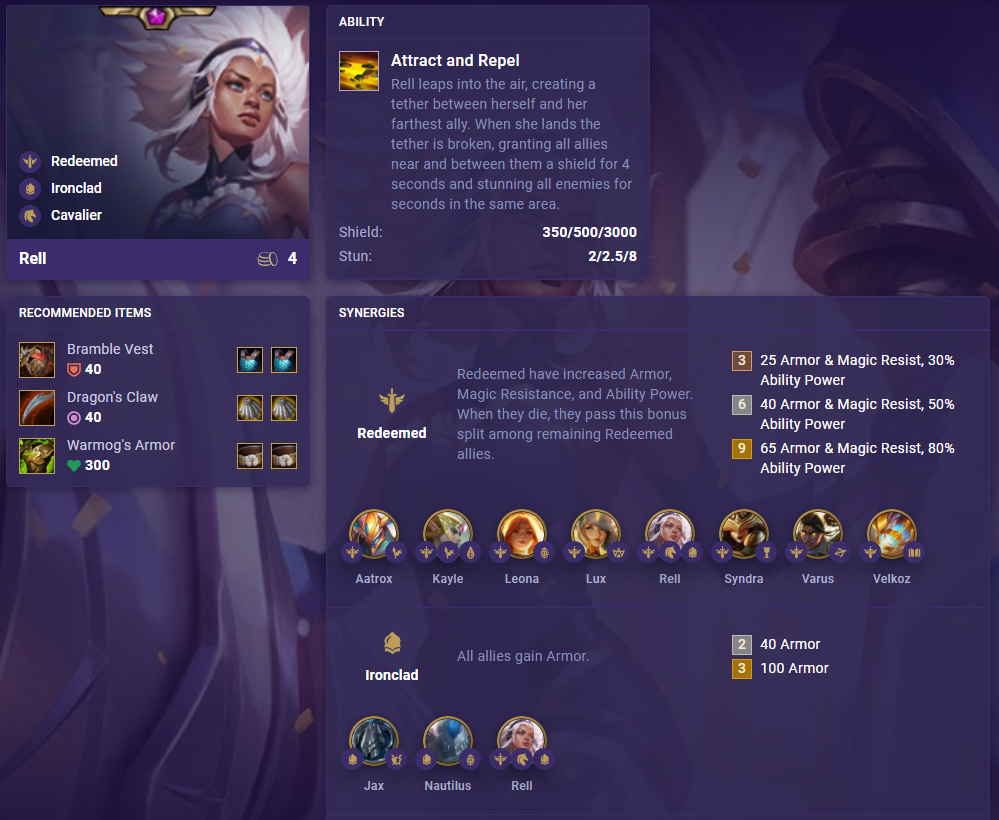
[See Rell’s TFT champion page]
First Impressions: Rell looks to be one of the best frontline CC units in the new Set. She’s clearly a tank with a very nice CC ability. Not only does her ability provide CC, but it also provides a shield for allies. I definitely think that many team comps will try to fit in Rell as a flexible Ironclad unit, much like how Mystic is often splashed into team comps.
Positioning: Frontline
Ryze – Forgotten Abomination Mystic
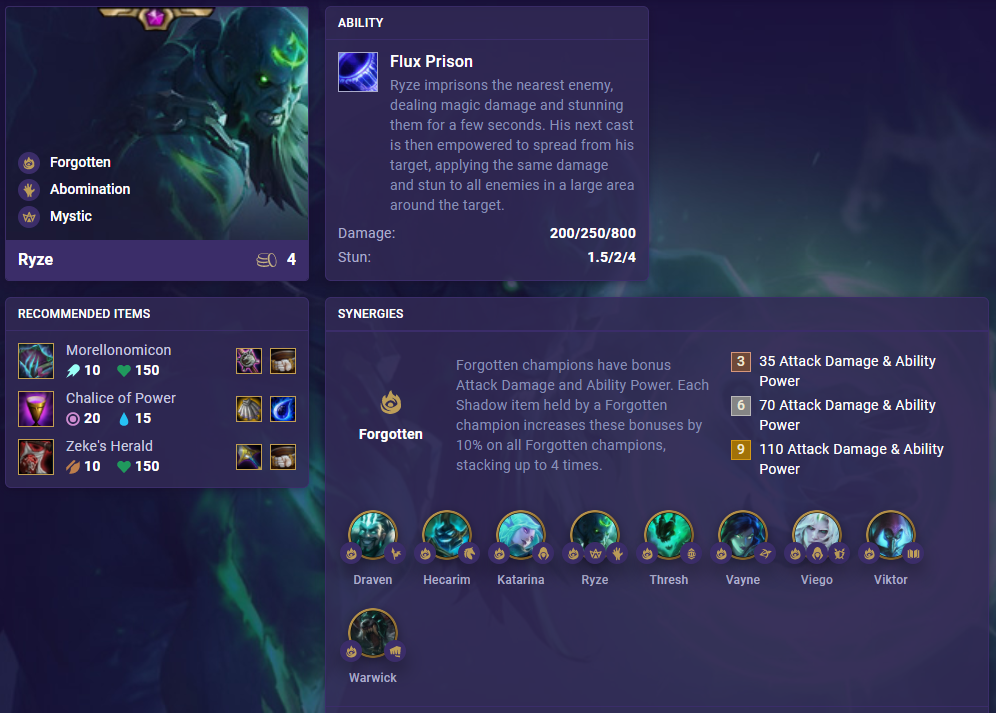
[See Ryze’s TFT champion page]
First Impressions: Ryze is a Mystic unit, meaning he can be splashed into many team comps. What’s unique about Ryze is that his ability provides strong CC and decent damage. Usually, Mystic units are fairly defensive, but Ryze is somewhat the opposite. When using Ryze, place him close to enemies that are grouped together so his second cast can spread to as many units as possible.
Positioning: Midline
Taric – Verdant Knight
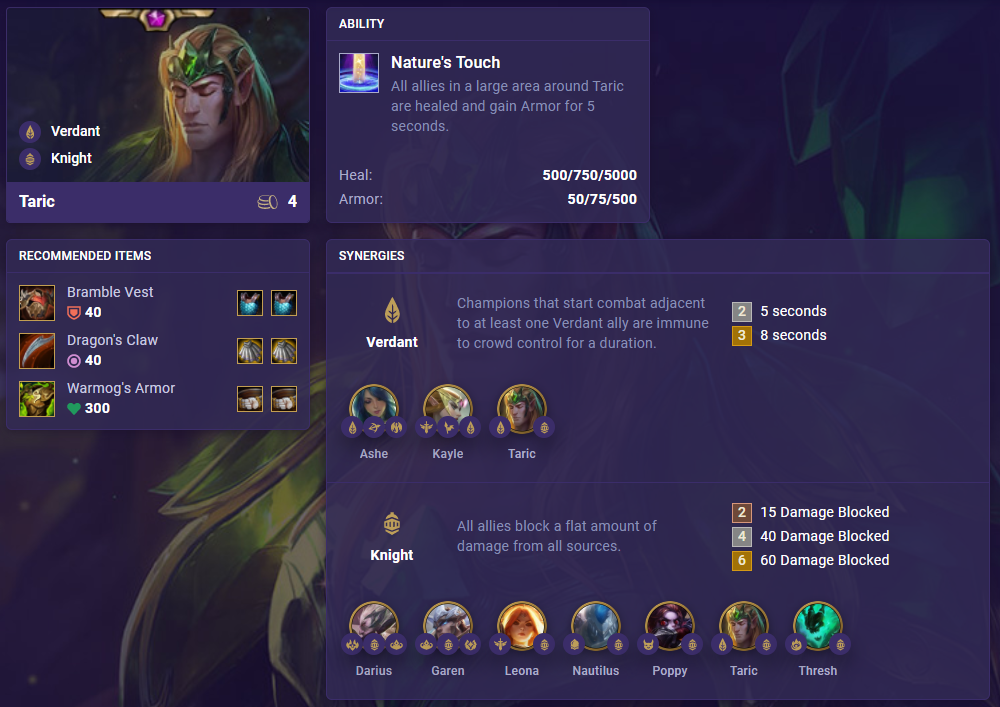
[See Taric’s TFT champion page]
First Impressions: Taric is interesting because his ability is very defensive. It provides Armor and healing to allies close to him, and his Verdant trait also buffs allies that are adjacent to him. I expect Taric to have a solid role in the late game meta, but he may not be prioritized over units that provide things like CC.
Positioning: Frontline
Vel’Koz – Redeemed Spellweaver
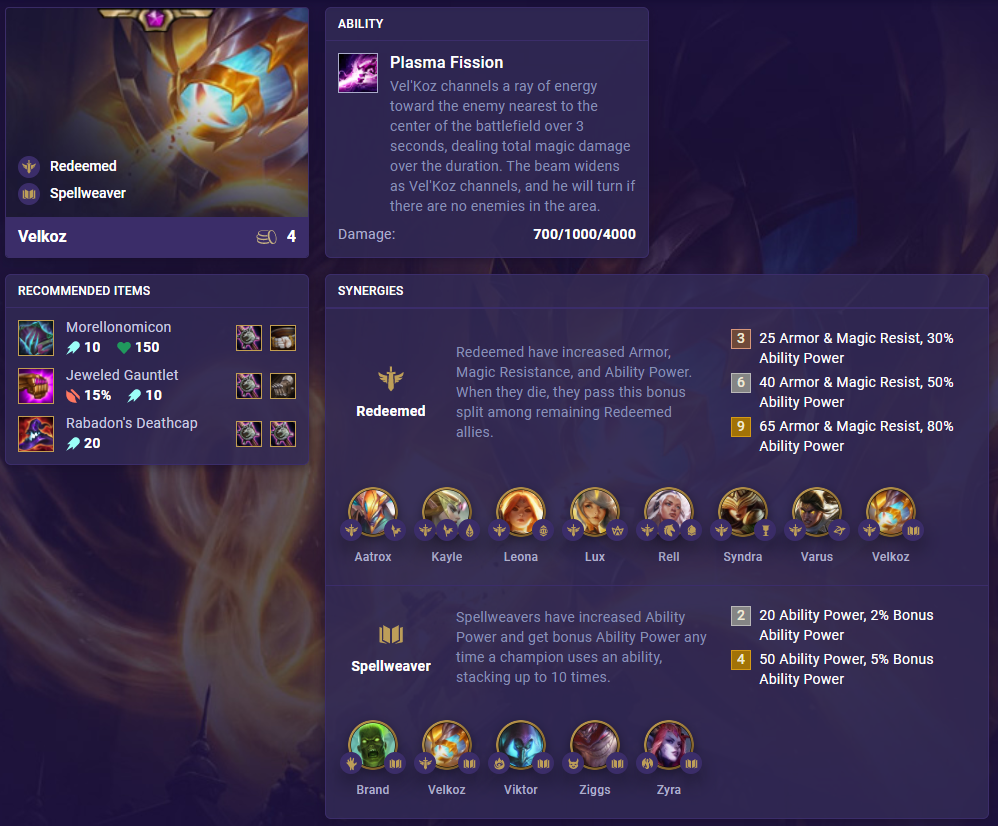
[See Vel’Koz’s TFT champion page]
First Impressions: Vel’Koz is the clear Spellweaver carry of the team. If his ability targets similar to how it did in previous Sets, you will want to place him on the side more in the middle of the board rather than straight in the back. However, things can change since Vel’Koz now always targets toward the center of the board. This may allow players to safely place him in the corner where he will almost always fire in a diagonal across the board.
Positioning: Midline / Backline Side
5-Cost Champions
Darius – Nightbringer God-King Knight
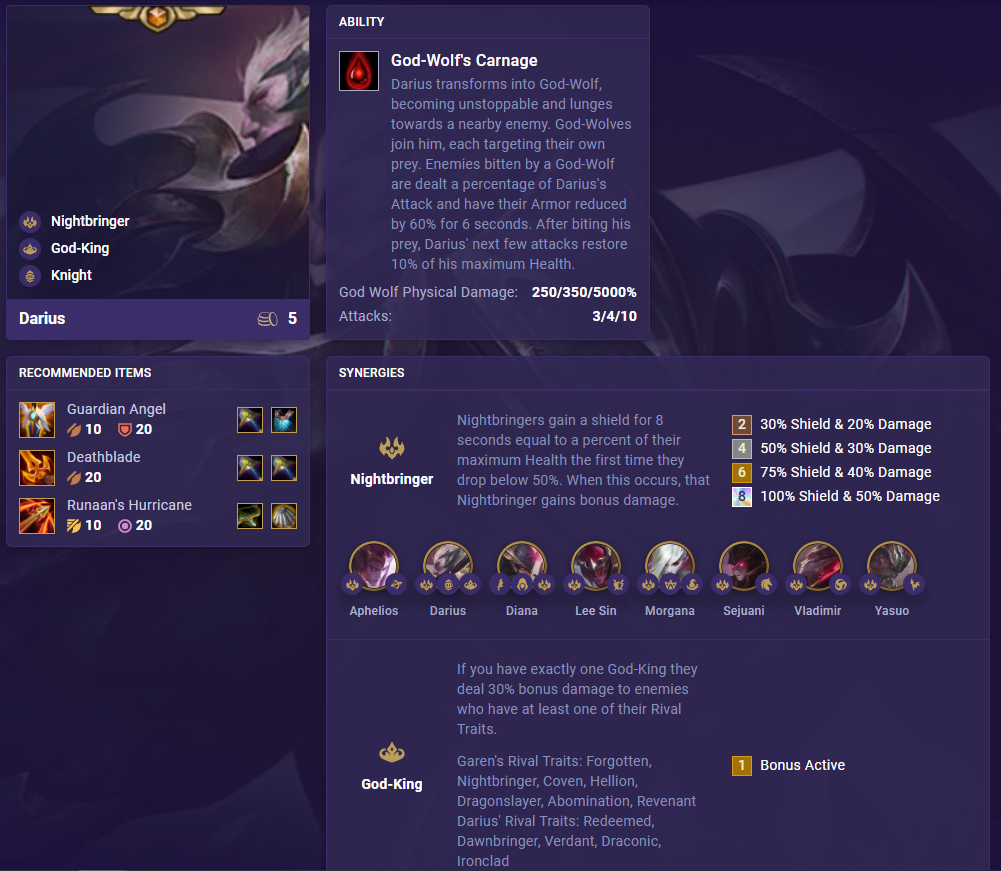
[See Darius’s TFT champion page]
First Impressions: Darius an extremely unique ability. He will transform and summon wolves to fight for him. Because of this, I assume an item like Deathblade and Hurricane will be amazing on him, but this is assuming his wolves proc Deathblade
Positioning: Frontline / Midline
Garen – Dawnbringer God-King Knight
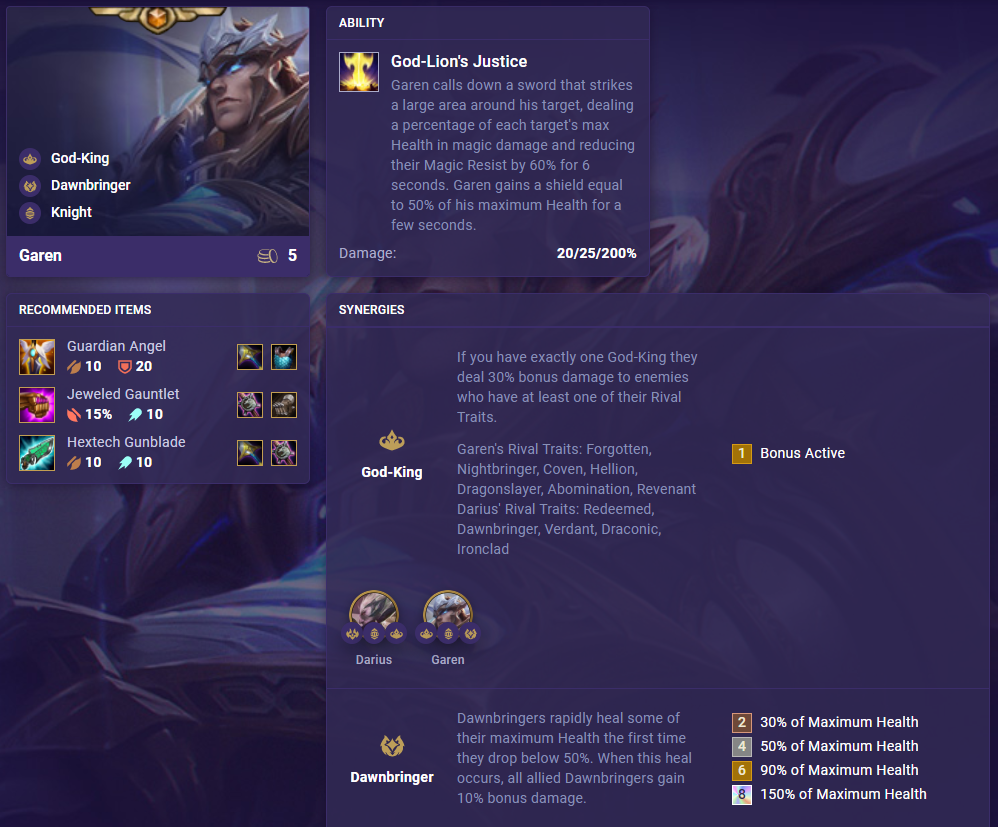
[See Garen’s TFT champion page]
First Impressions: Garen is a late game monster now with his ultimate ability from League. Unlike most carries, I would belive that you want Garen to take damage at the start of the fight in order to gain mana quickly. When combined with something like Gunblade, he should be able to heal most of his HP back in one cast.
Positioning: Frontline
Heimerdinger – Draconic Renewer Caretaker

[See Heimerdinger’s TFT champion page]
First Impressions: Heimerdinger is similar to Azir from Set 4 in that he gives you a turret to place on the board. Unlike Azir though, this Baby Dragon Turret will deal some crazy damage when it casts it’s fireballs.
Positioning: Backline
Kayle – Redeemed Verdant Legionnaire
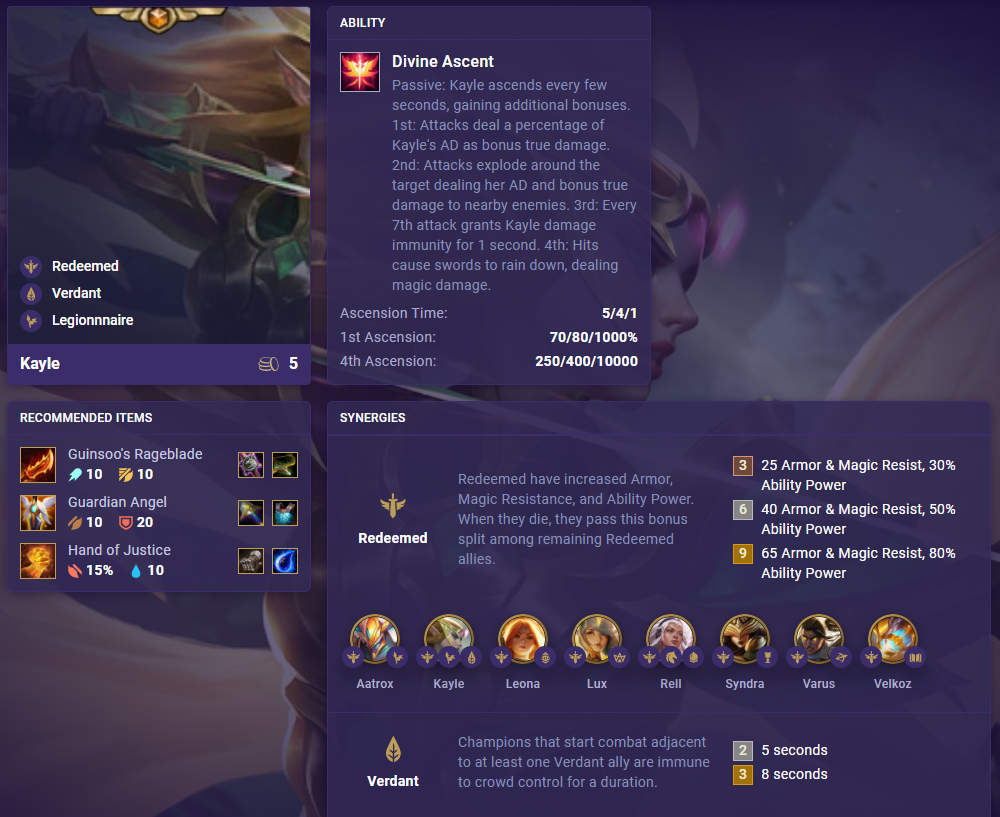
[See Kayle’s TFT champion page]
First Impressions: Kayle seems like the ultimate late game carry to me. Once she gains enough attack speed, she will be immune every 7th auto, which can be quite frequent if she’s attacking extremely fast. However, even at Kayle 2 star, the third Ascension will still take 12 seconds to take place, which can be quite long. She really needs a strong frontline to ensure she stays alive long enough to ascend fully.
Positioning: Backline
Kindred – Eternal Mystic Ranger

[See Kindreds TFT champion page]
First Impressions: Kindred is very unique because this unit really counts as two units on the board. This makes her a very attractive unit to run already as it provides two bodies for your team at the cost of one slot. Her ability is also extremely powerful as it can stall for your team to deal damage to enemies.
Positioning: Backline
Teemo – Cruel Hellion Invoker
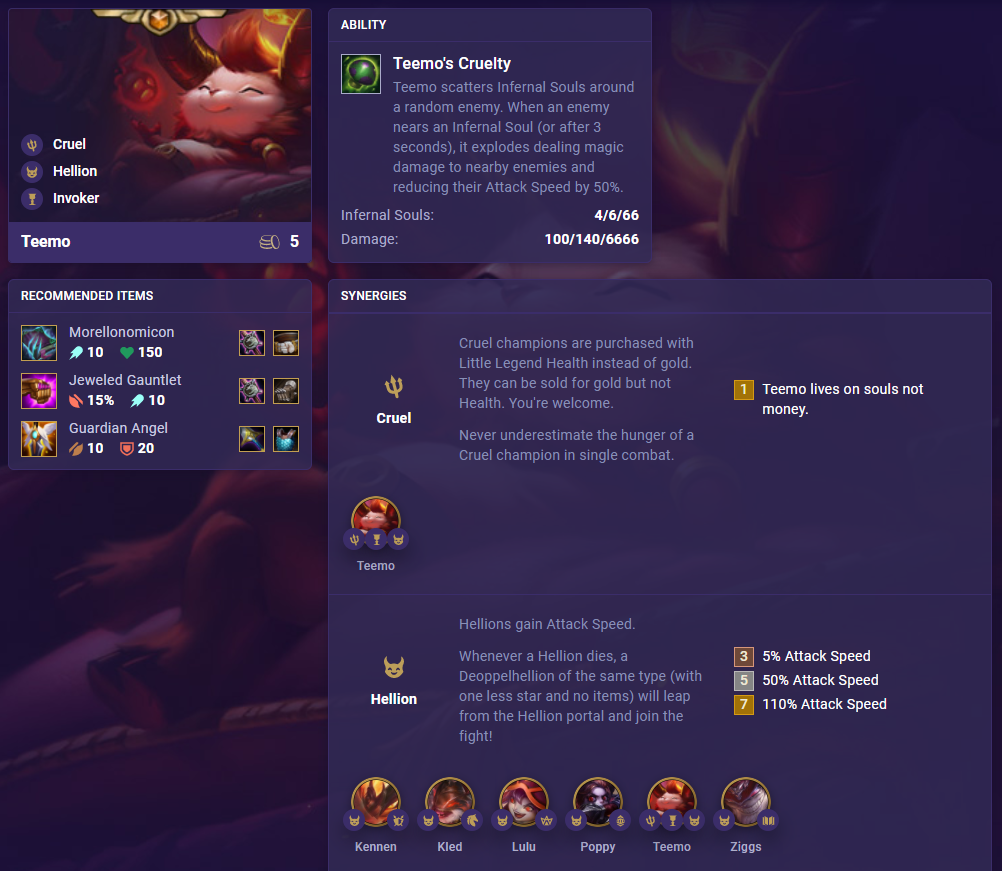
[See Teemo’s TFT champion page]
First Impressions: Teemo is a nice addition to the Set to give it some flair. Instead of costing gold, Teemo will cost health to buy. This means a 2-star Teemo will cost you 15 Health. This can be quite the price to pay in the late game. As such, it’s a risk to buy him, but if he’s strong enough to carry, the cost is well worth it.
Positioning: Backline
Viego – Forgotten Skirmisher Assassin 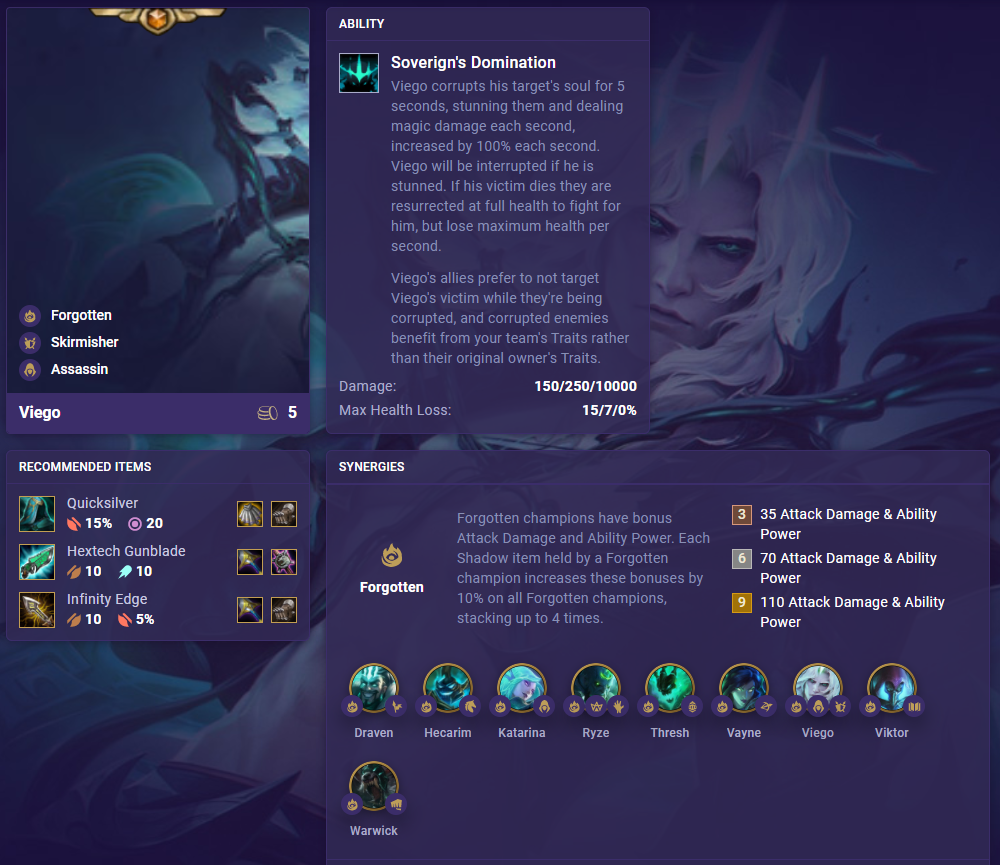
[See Viego’s TFT champion page]
First Impressions: Viego is quite the interesting carry. He’s an Assassin, so he will jump into the backline where he can be vulnerable to enemy damage or CC. His ability will also cancel if he is interrupted by CC. This makes Quicksilver seem to be one of his best items to ensure that his ability is not interrupted.
Positioning: Backline
Volibear – Revenant Brawler
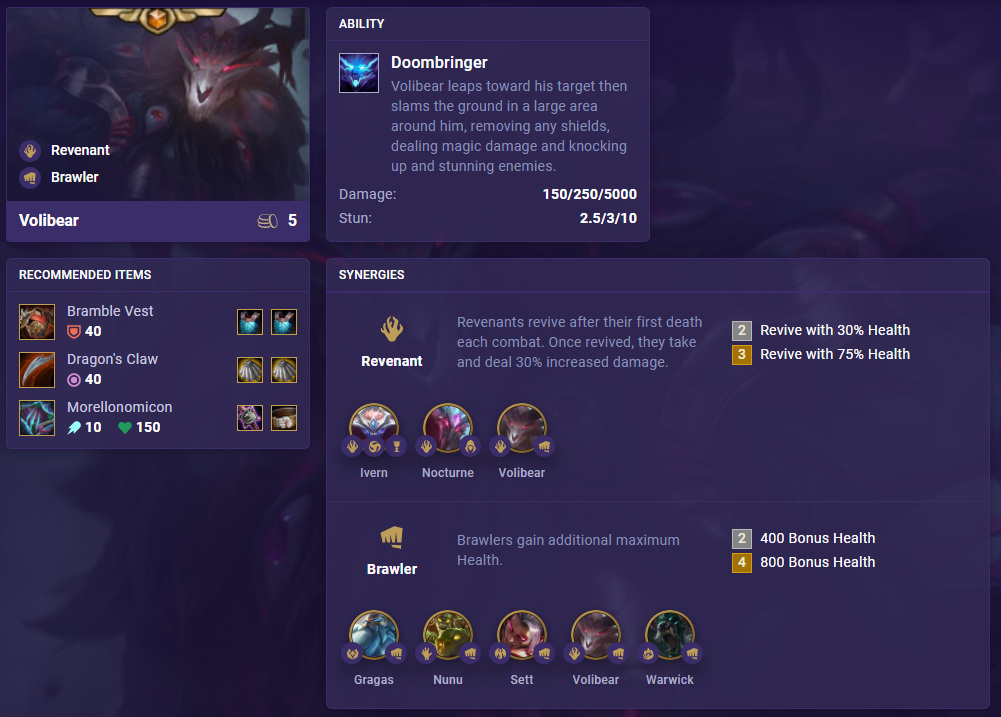
[See Volibear’s TFT champion page]
First Impressions: Volibear seems to be the only 5-cost unit whose job isn’t to deal massive amounts of damage. He looks to be an extremely tanky unit that provides a very strong CC for any team. He also has the effect of breaking enemy shields, which can be very useful in countering specific enemies or items.
Positioning: Frontline
Conclusion
That wraps up all of the new Champions and Traits coming to TFT Set 5: Reckoning.
For those going into the PBE server, I recommend planning out a simple comp to try out. It will be easier to simply try one thing one game and move onto the next.
Eventually, you’ll use more and more champions and start to get a feel for the game.
Thanks for reading! Head to our Team Builder to start theorycrafting and be sure to check our best meta comps to find another answer to climb with once TFT Set 5 hits live!
To learn about the new TFT Set, head to our all-in-one Teamfight Tactics Set 6 reveal page that covers all champions, synergies, and more!
Subscribe to our newsletter:
Don’t miss out on all of the latest TFT content!
 Download APP
Download APP Collapse
Collapse